Paris Fashion Week A/W 2023: Chanel to Miu Miu
The best of Paris Fashion Week A/W 2023 in our ongoing round-up, from an evocation of the camellia flower at Chanel to Miuccia Prada’s ‘ways of looking’ at Miu Miu
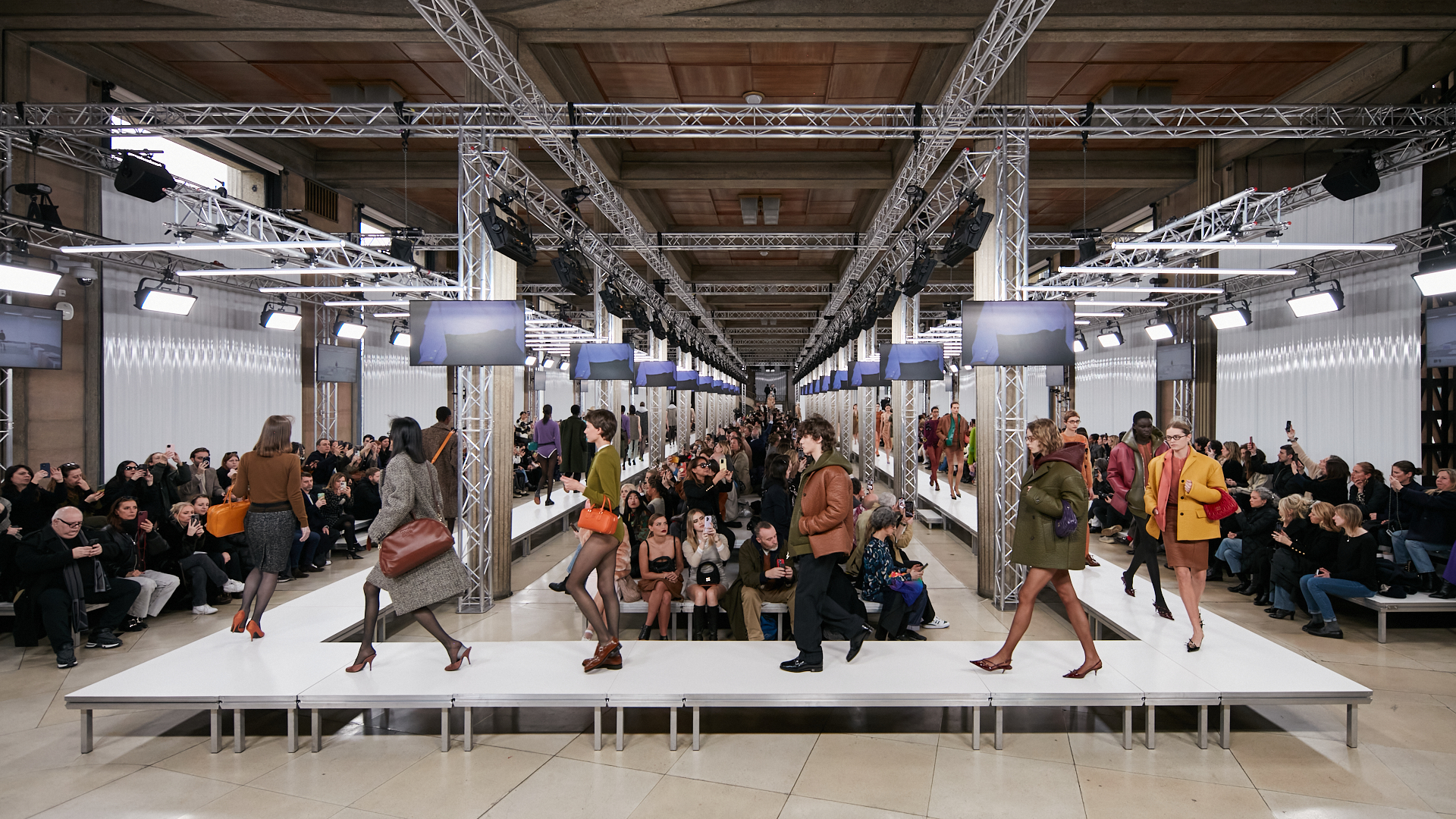
Paris Fashion Week A/W 2023 took place in the city this week, its arrival marking the end of a month-long fashion tour that has previously seen stops in New York, London, and most recently, Milan.
Long synonymous with style and craft – Paris is home to the historic ateliers of storied maisons like Dior, Saint Laurent and Givenchy – the city hosted shows from both established houses and rising names, from home and abroad.
This season came complete with designer debuts (Ann Demeulemeester and Nina Ricci both have new creative directors in Ludovic de Saint Sernin and Harris Reed respectively), runway returns (Alexander McQueen returned to Paris after showing in London and New York in recent seasons; Paco Rabanne and Y/Project also made a return to the womenswear season) and rising names, like Vaquera, Ester Manas and Weinsanto, which brought new energy to the week.
Alongside were new collections from the wide gamut of designers and houses that have long called Paris Fashion Week home – Louis Vuitton, Dior, Chanel, Saint Laurent, Loewe, Hermès, Valentino, Givenchy and Miu Miu among them.
Here, the best of Paris Fashion Week A/W 2023.
Paris Fashion Week A/W 2023: the highlights
Y/Project
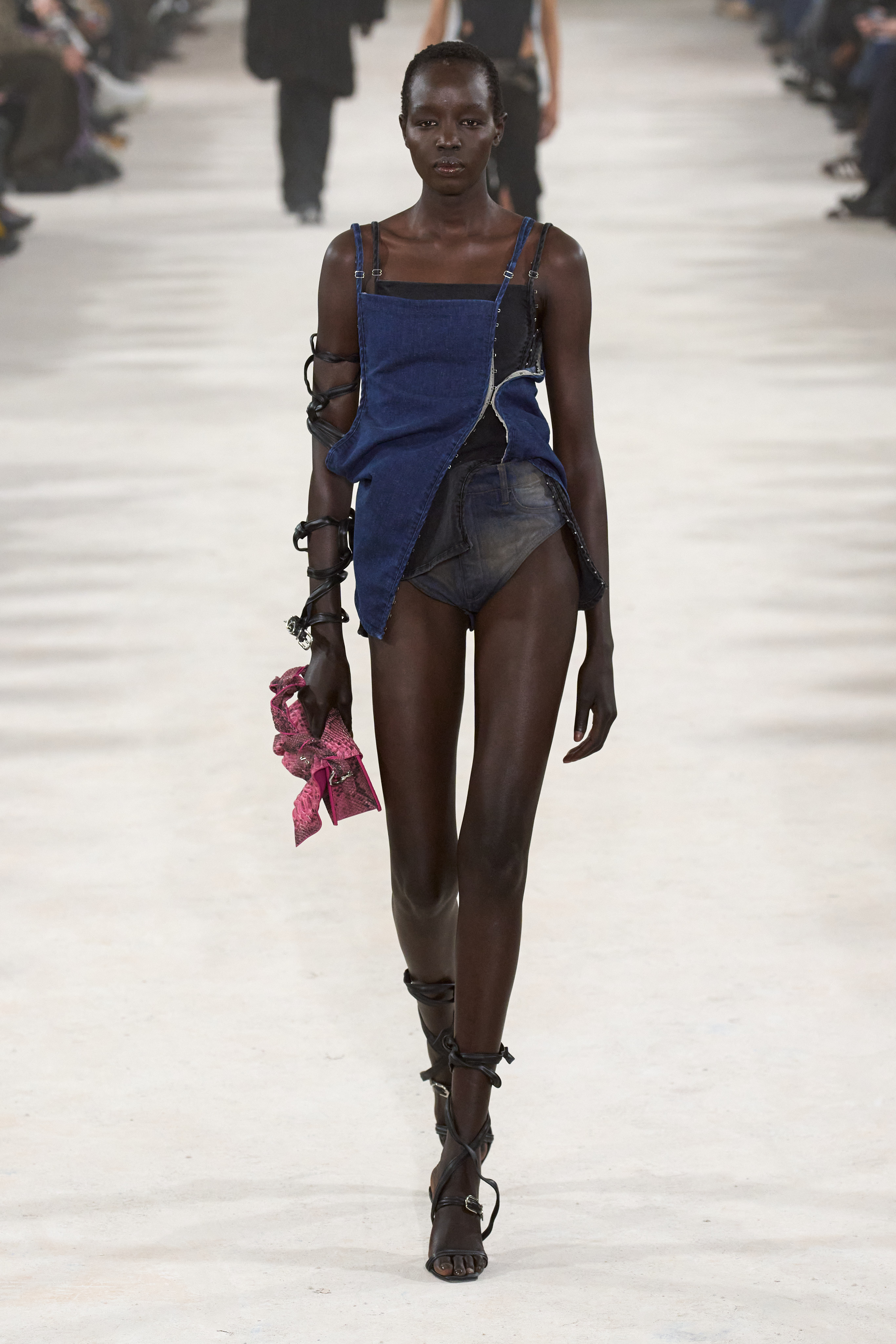
Y/Project A/W 2023
Closing Paris Fashion Week for the season, Belgian designer Glenn Martens – who showed a sexually liberated collection for Diesel earlier in the month in Milan – said his latest Y/Project collection had been informed by George Frideric Handel’s Lascia ch’io pianga, which he had been listening to throughout its creation. In particular, he picked out the line ‘let me weep over my cruel fate, and let me sigh for liberty from the choral aria, which for him captured not simply pain, but ‘serenity and solemnity’ – words the designer chose to describe the collection itself, which reflected the emotion of the collection’s soundtrack (in English, Lascia ch’io pianga translates to ‘let me weep’). ‘We decided to try and do something beautiful,’ said the designer after the show, describing a continuing focus on technique; here, that emerged in intricately layered denim jackets (the appearance was that of a concertina), sheer gowns over which frayed denim spiderwebbed with the elegancy of traditional embroidery, and intricate hook-and-eye fastenings. Of course, elements of subversion – for which Martens is known – remained, notably in the evocation of Lars Von Trier‘s 2009 erotic horror Antichrist (Lascia ch’io pianga runs over the movie’s prologue) in sliced-up pornographic screenshots which adorned garments throughout.
Miu Miu
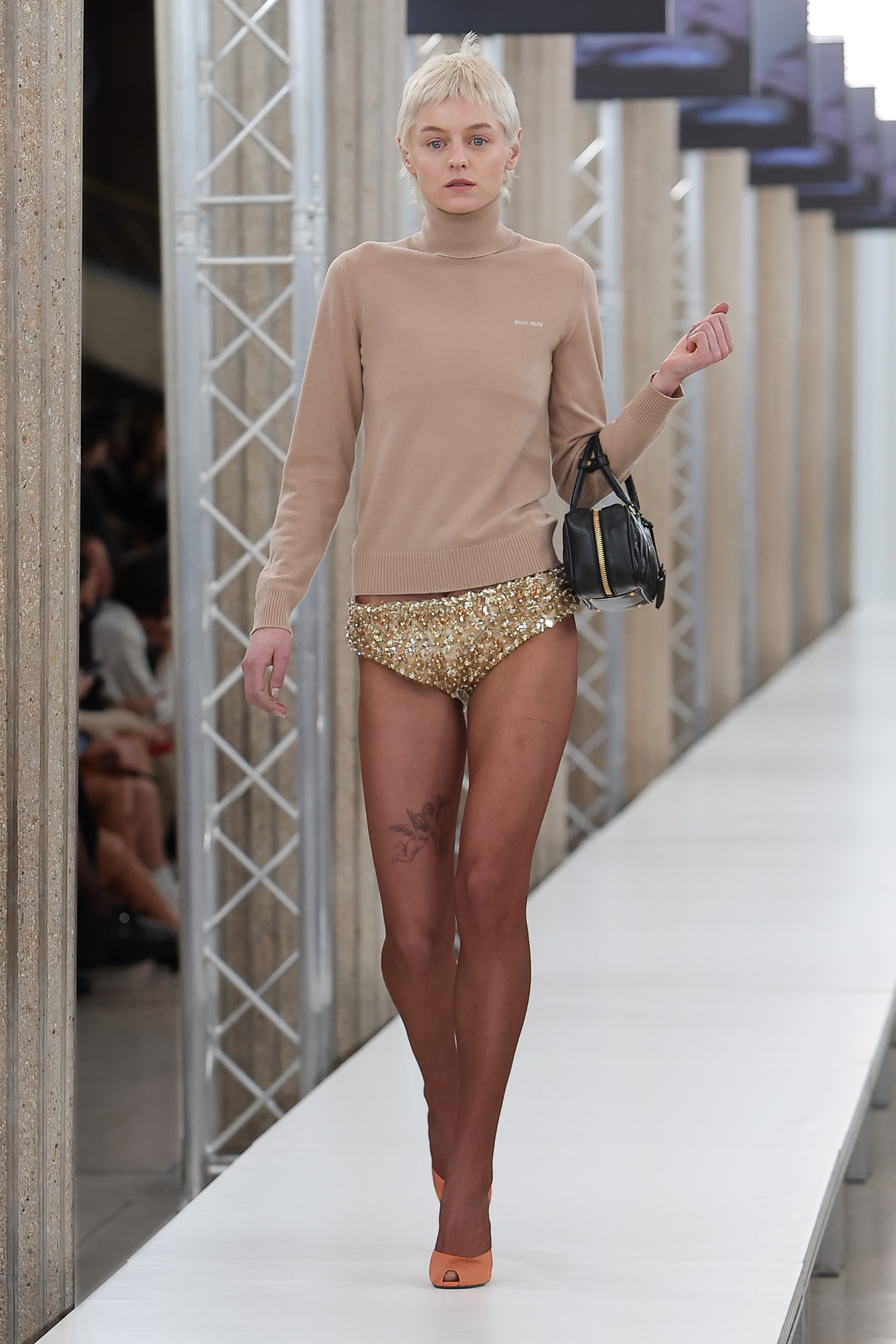
Miu Miu A/W 2023
Miuccia Prada said that her latest Miu Miu collection was about ‘ways of looking’. ‘I am always interested in how people look at things, their consideration… why people are attracted to certain ideas, why others repulse them,’ said the designer of the collection, which was presented with a starry cast that included musician Ethel Cain, Zaya Wade (daughter of Dwyane Wade and Gabrielle Union in her runway debut), and actors Mia Goth and Emma Corrin. The latter walked the runway – a raised platform ‘to aid observation’ which ran through the Palais d’Iéna space – in a pair of crystal knickers and a beige turtleneck jumper, setting something of a blueprint for the collection which combined the banal (marl grey hoodies, knit sweaters, classic overcoats) with frissons of glamour and subversion. Like the Miu Miu-branded hosiery which peeked above the waistband of mid-length skirts (some looks saw cardigans tucked into tights for a playful take on layering), or sheer polka-dot dresses which were purposely rumpled and allowed glimpses of underwear beneath (rumpled too was the hair, which was lightly dishevelled, while round tortoiseshell glasses and handbags carried in the crook of the hand lent an eccentric, bookish air). Touches of adornment came in flowers stitched onto sheer knit cardigans and skirts. ‘[This collection is about] how fashion and fashion design can change perceptions, of things we think we know,’ Miuccia Prada added. ‘It’s an invitation to reconsider.’
Wallpaper* Newsletter
Receive our daily digest of inspiration, escapism and design stories from around the world direct to your inbox.
Chanel
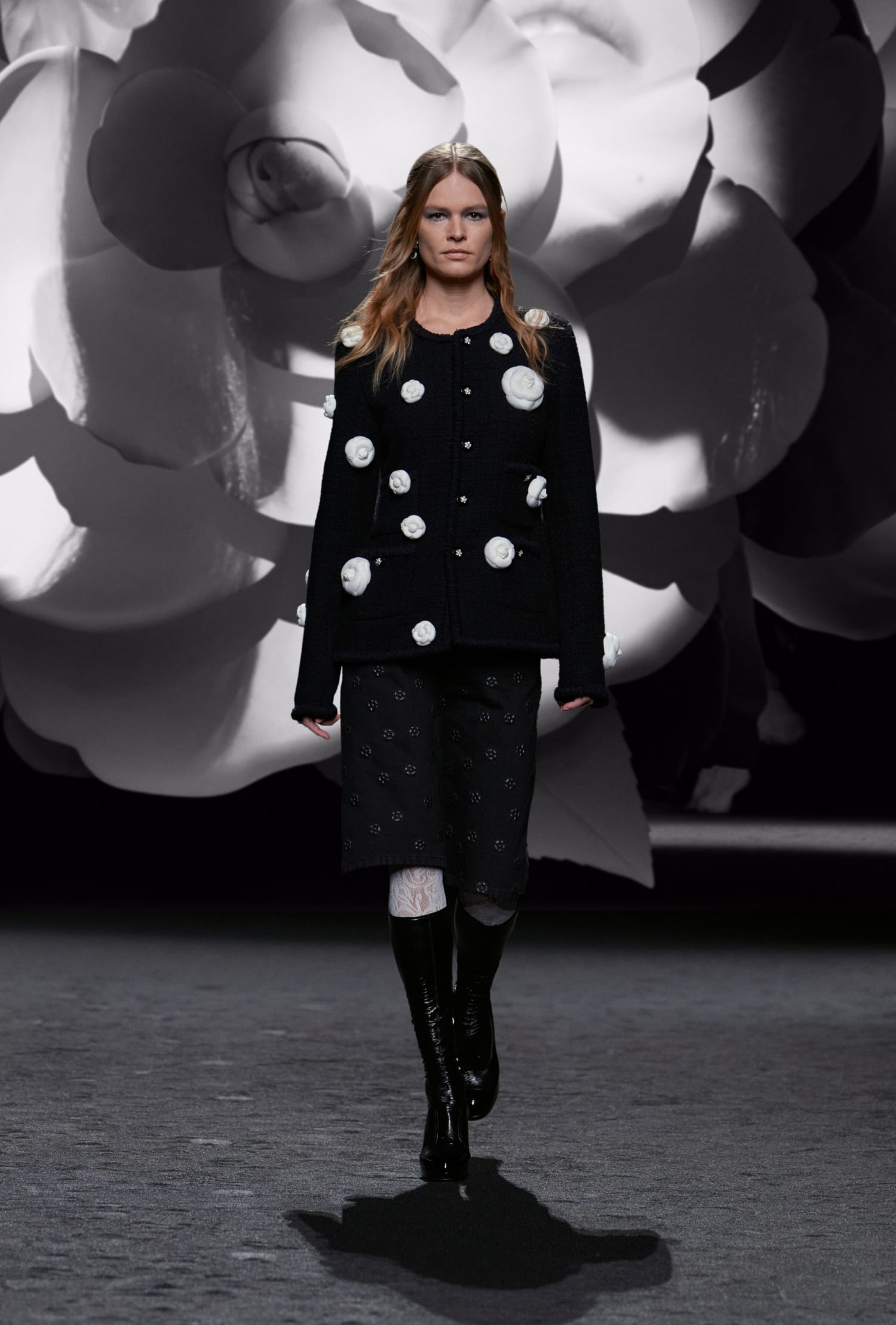
Chanel A/W 2023
The camellia is a perennial emblem of Chanel, a flower beloved by house founder Gabrielle ‘Coco’ Chanel after purportedly being inspired by a performance of Alexandre Dumas’ La Dame Aux Camélias (she began by wearing silk versions of the flower; later, it would feature in her designs and in the decor of her home). A blown-up version of the flower – which has come to represent a feeling of simplicity and purity intrinsic to the house – appeared in the centre of the show set for Virginie Viard’s latest ready-to-wear collection at Grand Palais Ephémère (a real version appeared on attendees’ seats). ‘The camellia is more than a theme, it’s an eternal code of the house,’ said the designer. ‘I find it reassuring and familiar, I like its softness and its strength’. As such, the camellia adorned several of the collection’s looks, whether woven into the house tweed and adorning an overcoat, blooming across handbags and tailoring as a 3D embellishment or recalled in the plumes of white feathers which emerged from a knitted jumper and skirt. Viard said the collection had a feeling of romance, evoked here not just in the floral motifs, but in the generous asymmetric cut of overcoats and dresses, flouncy skirts and shades of pink which recurred in the latter half of the collection. More masculine elements – wide lapels, elongated and oversized overcoats – provided a counterpoint. ‘The faded colours, the dusky pink, the crafted pieces, the touches of 1960s and 70s, a certain English vibe, the comfortable, enveloping coats, the authentic materials, make the collections more real, and more charming too,’ said Viard.
Louis Vuitton
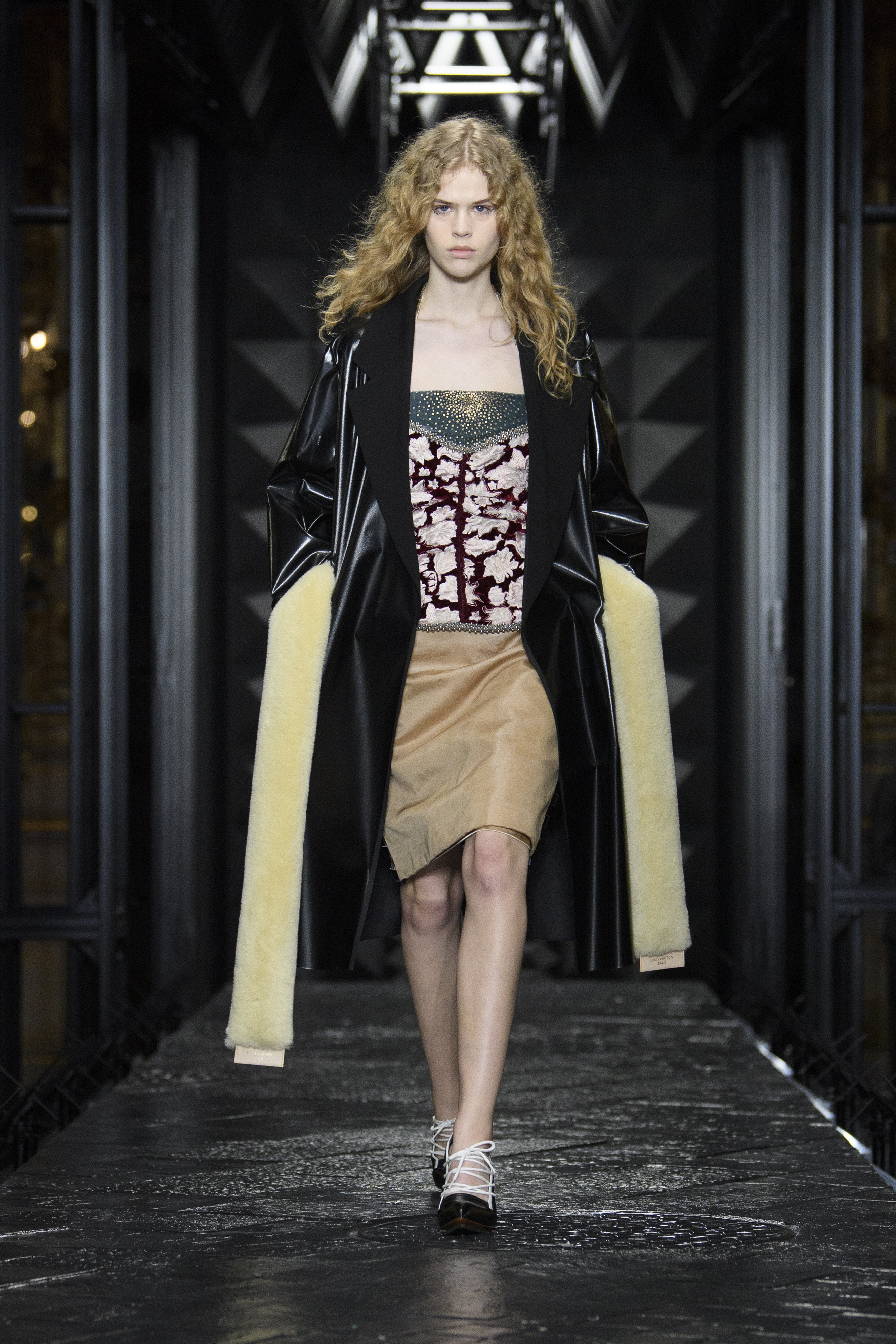
Louis Vuitton A/W 2023
‘What is French style?’ was the question Nicolas Ghesquière posed with his latest collection for Louis Vuitton. Staged in the gilded salons on the upper floors of Musée d'Orsay – a former train station and landmark of Beaux-Arts architecture – the space was interrupted with a starkly contemporary set by French artist Philippe Parreno in collaboration with Hollywood set designer James Chinlund (last season, they created a vast ‘monster flower’ for Ghesquière’s previous show at the Louvre). Here, their spiked black runway – its surface recalling paving stones or cobbles – featured a number of speakers, creating a series of immersive ‘sound illusions’ by Academy Award-winning composer Nicolas Becker as the show went on. From honking car horns and clacking heels to the sounds of aeroplanes overhead, it was meant to evoke the feeling of being on a Parisian street – an apt setting for Ghesquière’s exploration of the ‘ineffable magnetism’ of French dress codes, which he said was ‘paradoxical... sophistication with a dilettante’s air’. Indeed, in Ghesquière’s typically expansive style, the collection captured the insouciance and elegance of French style – thrown-on tailoring, cocooning overcoats, ladylike handbags and gloves – opposing a feeling of effortlessness with extraordinary feats of craft (in particular, intricate beading, embellishment and jacquards, which recalled the traditions of Parisian haute couture). Jolts of futurism, a hallmark of Ghesquière’s work, appeared throughout – like a pair of light-up glasses (evocative in shape of a welder’s mask) or the sculptural shape of the collection’s gowns. ‘The maison is a vessel sailing through time, guided by the winds of savoir-faire, technique, discovery and artistic ideals,’ said the collection notes. ‘The French touch never fails to captivate.’
Valentino
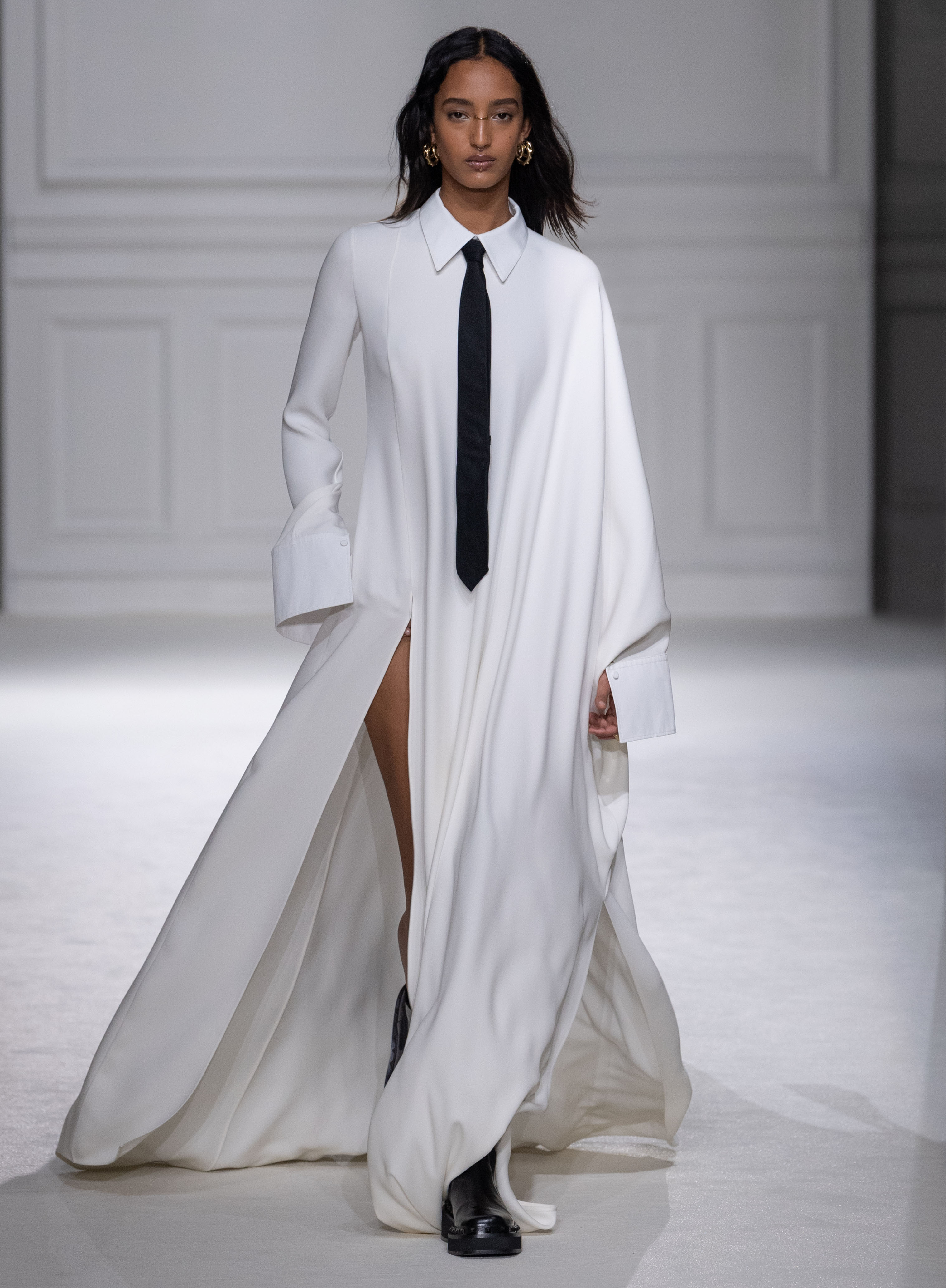
Valentino A/W 2023
Pierpaolo Piccioli titled his latest collection ‘Valentino Black Tie’ – an exploration, the Italian designer said, of the perennial dress code. Here, his desire was to liberate it of connotations with strictness: ‘an instruction can become an invitation… archetypes can be re-imagined, and a power in the familiar can come from its rediscovery in a new context’, he said via the collection’s notes. The nexus of the collection was his teenage daughter, who had recently raided Piccioli’s wardrobe for a suit and tie, which she then wore for an evening out with friends. This mood of experimentation informed the collection’s looks, all of which featured a literal black or white tie: whether worn with a classic buttoned-up white shirt, tucked under a striped jumper or over a draped red dress. As ever, dramatic flourishes of embellishment and craft ran throughout the eclectic collection – comprising both mens- and womenswear – from the usual feathered plumes (adorning a jacket or sprouting from a pair of military-style boots) to cut-outs, shimmering paillettes, or the thousands of crystals which decorated a sheer, robe-style gown towards the end of the show. ‘Signifiers are re-appropriated, transforming into different garments,’ said the house. ‘The tie is untied, unfettered, sliding between the form language of clothes, between day and evening.‘
Akris
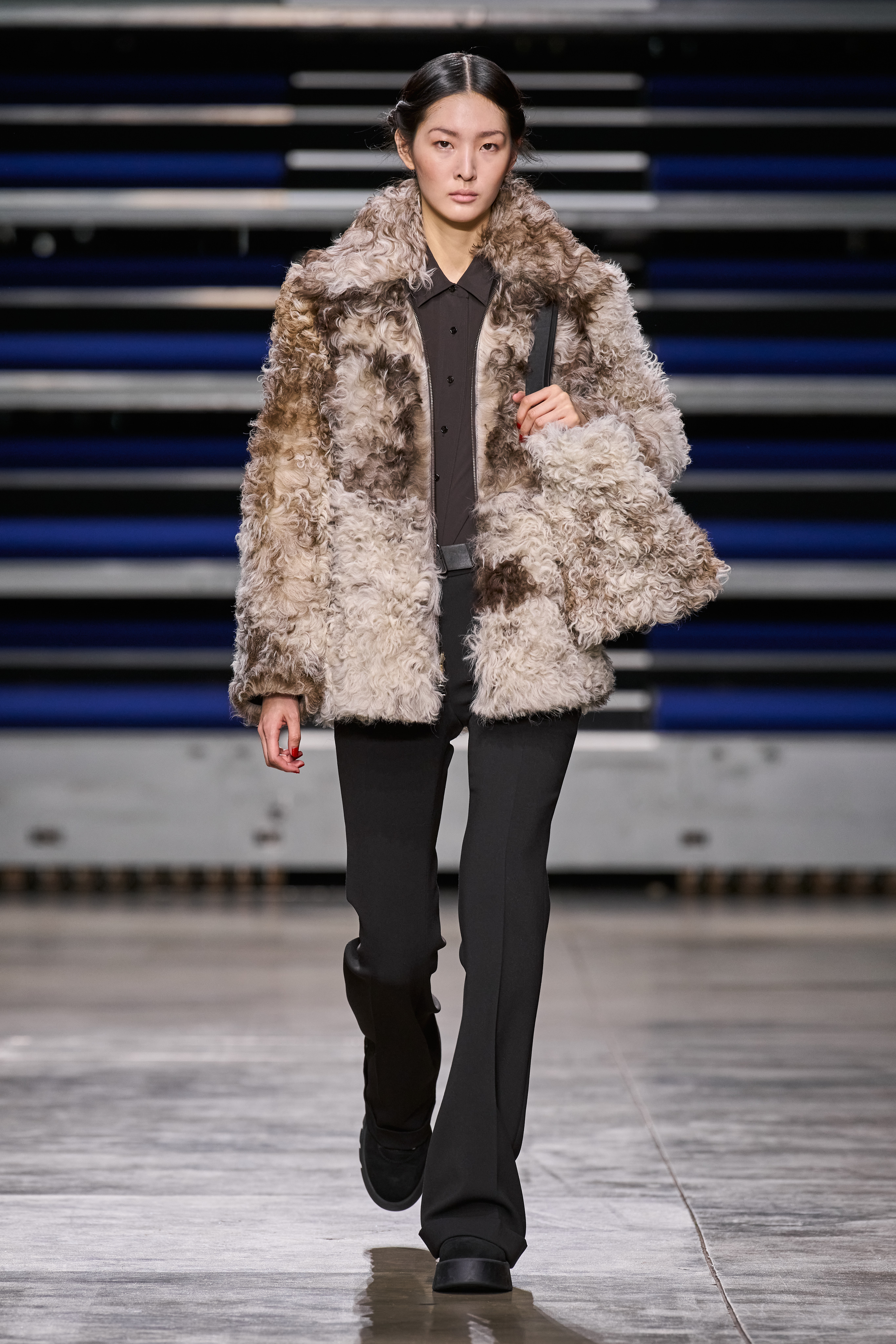
Akris A/W 2023
Akris continued its celebration of 100 years in business with a show titled ‘A Century in Fashion Part II’ (last year at the Palais de Tokyo the brand presented the opening part with a collection interspersed with archival designs). This time, creative director Albert Kriemler looked towards a formative decade, the 1970s, with a collection which sought to capture the era’s liberatory spirit. ‘An unexpected find in the archive, three boxes of 1970s paper patterns, made me think of a woman’s new sensibility towards freedom of movement and freedom of choice to celebrate the second act of Akris’ 100 years,’ said Kriemler in a statement. In particular, he recalled the year 1972, when his father Max Kriemler stopped making the aprons for which the Swiss brand was originally known and opened an atelier for women’s tailored suits and coats. ‘[He] brought Italian menswear masters and their knowledge of double-face to us. He felt there was a need for change… [for] the woman who moves, a woman with a voice.’ As such, tailoring and outerwear were a focus: whether a raglan-sleeve tweed overcoat, nipped-waist double-breasted or three-button suiting (the latter in golden pearlised suede) or the array of 1970s-tinged shearling coats that sat alongside. Another reference to the era came in the collection’s prints: a 1976 floral motif by Zurich-based silk company Abraham, found in the Akris archive, was reworked throughout.
Balenciaga
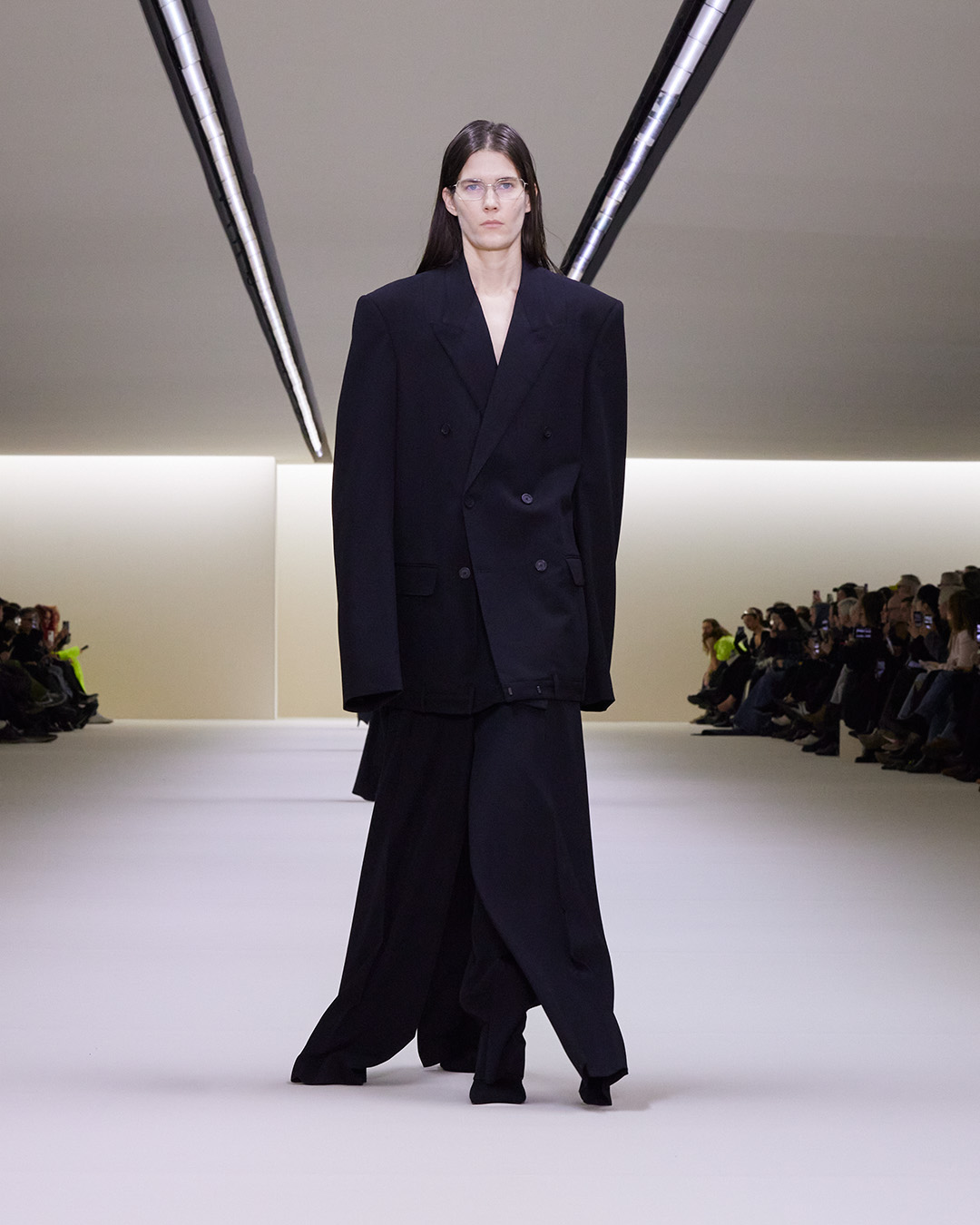
Balenciaga A/W 2023
After the house’s advertising scandal in November 2022, creative director Demna said that his latest collection for Balenciaga sought a feeling of reset – a return to his own lifelong love affair with making clothes (a note from the designer recalled having a pair of trousers fitted by a neighbouring tailor as a child; the collection’s invitation was a selection of pattern pieces used to construct a tailored jacket). In opposition to the usual theatrics that have previously surrounded his shows – last season saw a vast pit of mud through which models trudged – the space in the Carrousel du Louvre shopping centre was the neutral colour of toile, a simple twill fabric used to create a sample garment. ‘Fashion has become a kind of entertainment,’ the designer said. ‘But that part often overshadows the essence of it, which lays in shapes, volumes.’ As such, the collection riffed on elements which first brought Demna to prominence at both Vetements and Balenciaga: off-kilter tailoring (here, oversized tailoring had belt loops along the hem, as if cut from a pair of trousers), warped silhouettes (a biker jacket sat high and hunched on the shoulder; other pieces appeared as if a chest plate was being worn underneath), and elements of subversion and kitsch (jeans appeared like another pair had been sewn on top; high-heeled ‘tight’ shoes gave the appearance models were walking on tip-toes). It ended on a stream of couture-level gowns, richly embellished and with amplified rounded shoulders. ‘In the last couple of months, I needed to seek shelter for my love affair with fashion and I instinctively found it in the process of making clothes,’ he said. ‘It reminded me once again of [its] amazing power to make me feel happy and truly express myself. This is why fashion to me can no longer be seen as entertainment, but rather as the art of making clothes.’
Lanvin
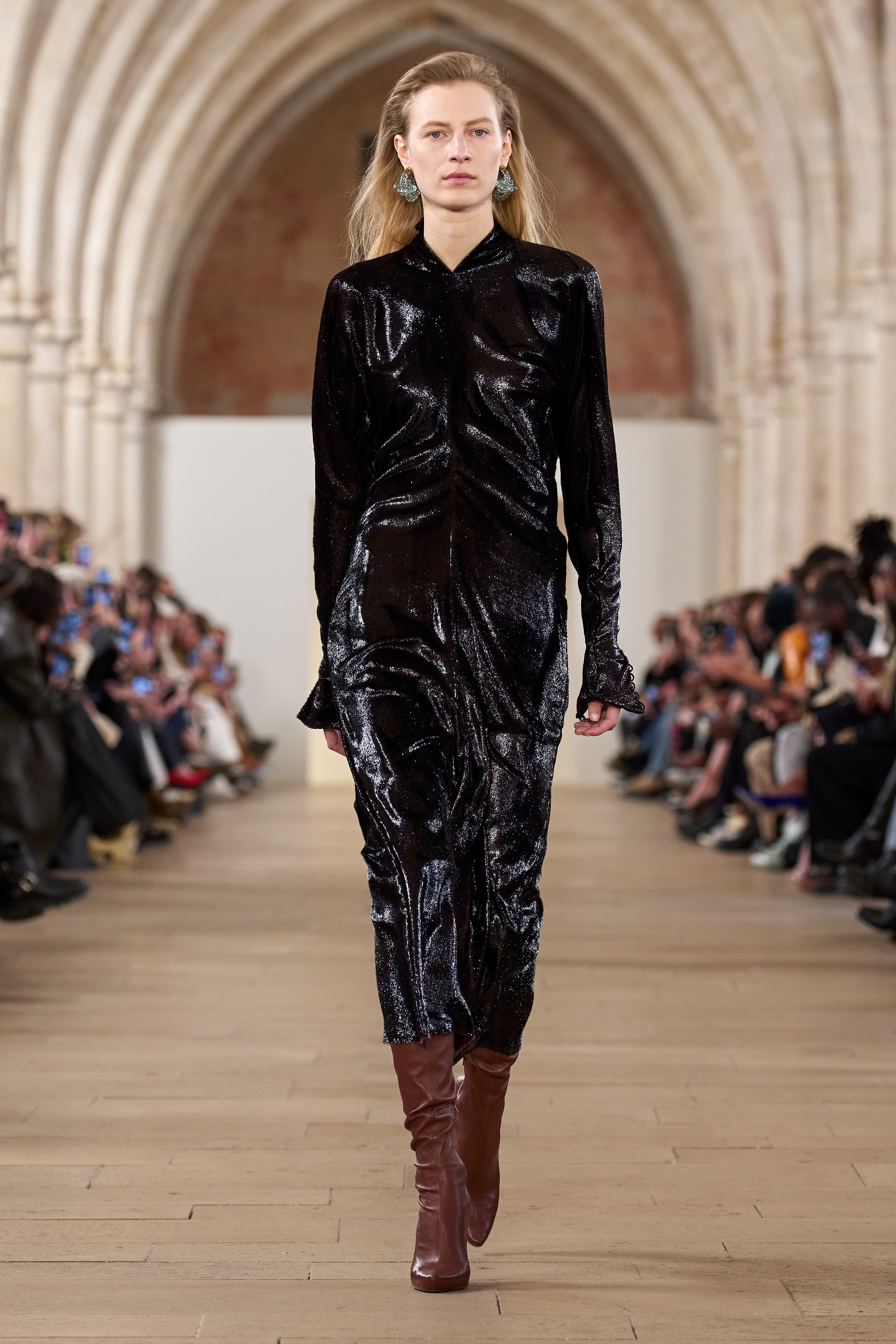
Lanvin A/W 2023
Bruno Sialelli said that his latest collection was a return to ‘the joy of making, of discovery and rediscovery’. It spoke to a wider mood this season of designers eschewing theatrics in favour of considered design and craft; in the collection notes, Sialelli evoked the words of Swedish-American sculptor Claes Oldenburg as an explanation of sorts. ‘Making things, what fun,’ reads the extract, taken from Oldenburg’s 2012 ‘Still Life Exhibition’. ‘An ordinary grey shelf, that occupies a wall of the studio, lay me in the shelf and let the thirsty eye decide, each one a description of ingredients that have attracted me.’ The collection itself was a reflection of Sialleli’s own preoccupations, his ‘thirsty eye’: elements inspired by the 1940s and 1980s, a rich array of fabrications (velvet, devoré and wool gazaar all featured), and moments of embellishment, like delicate crystal flowers which adorned languidly glamorous dresses. ‘The collection is a rediscovery of French elegance and exuberance,’ said the house. ‘The very soul of Lanvin.’
Alexander McQueen
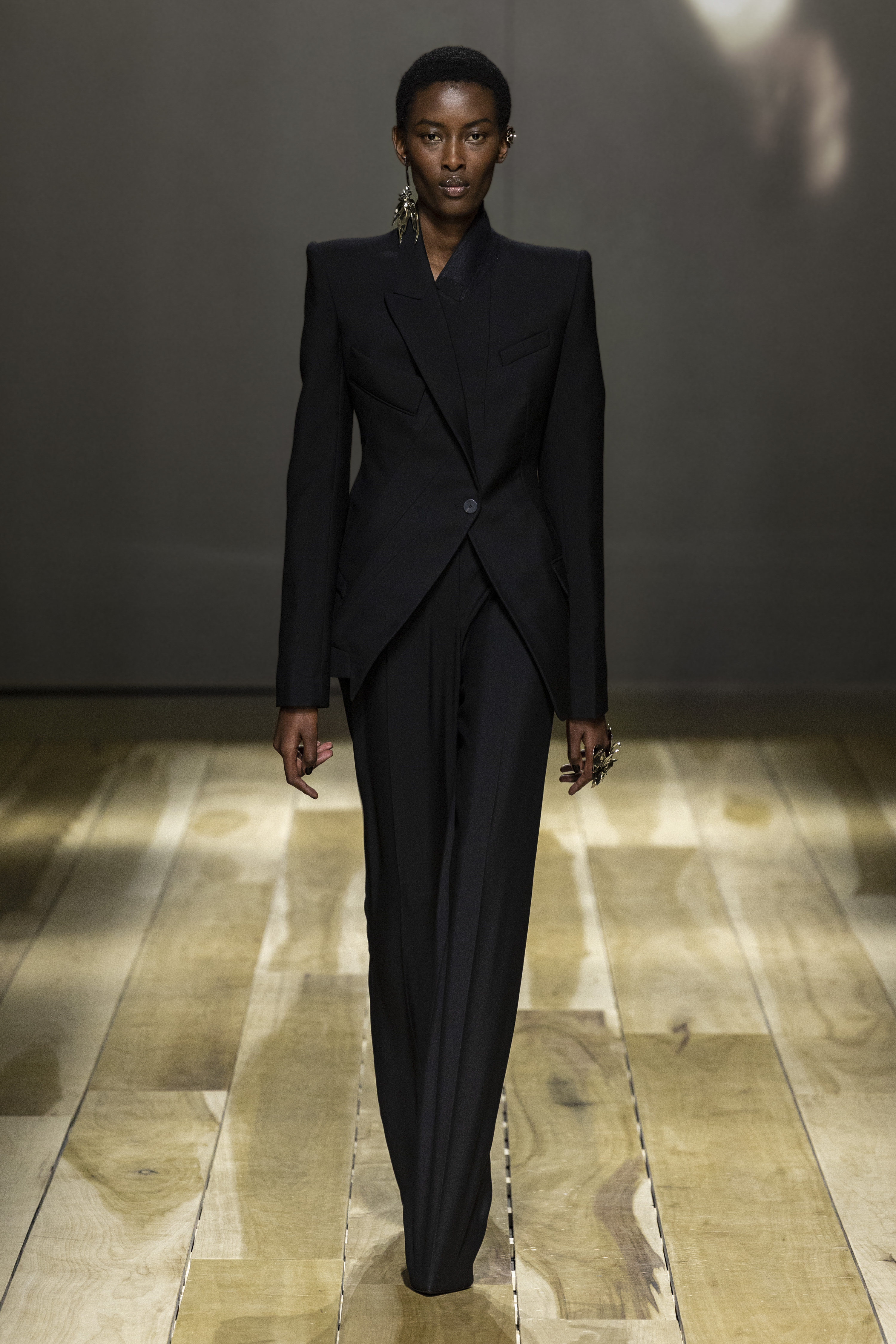
Alexander McQueen A/W 2023
Sarah Burton marked her return to Paris Fashion Week with an in-the-round collection which the designer said drew on the idea of anatomy – ‘human anatomy, the anatomy of clothing, the anatomy of flowers’, each one rooted in the history of the brand, and perennial touch points for its founder Alexander McQueen. It figured in an exploration of tailoring, a series of pin-sharp silhouettes which infused the classic black suit with elements of subversion: Naomi Campbell opened the show in a corseted tailored jumpsuit in black wool barathea (first developed for men’s mourning clothes in the mid-19th century), wide-leg tuxedo trousers came with built-in heels (‘heeled trousers elongate the leg: the bumster in reverse,’ said Burton), and a sleeveless bustier dress had a double-breasted fastening, meant to evoke an upside-down suit jacket. ‘The foundations of fashion, cut on the body and inspired by the body within… the classic subverted, turned inside out and upside down,’ Burton elucidated. Elsewhere, the designer looked towards the evocative shape of the orchid, its form adorning trench coats and dresses, and providing inspiration for the dramatic silhouettes of the intricate ruffled and beaded gowns which closed the show. ‘The most prominent motif in the collection is the orchid, in its rarer forms cultivated but, after the daisy, the most common flower,’ said Burton. ‘It thrives in the air, resists being rooted and grows in the wild. Extraordinarily beautiful and infinitely adaptable, the orchid mimics both predator and prey. In the language of flowers, the orchid is a symbol of love.’
Ann Demeulemeester
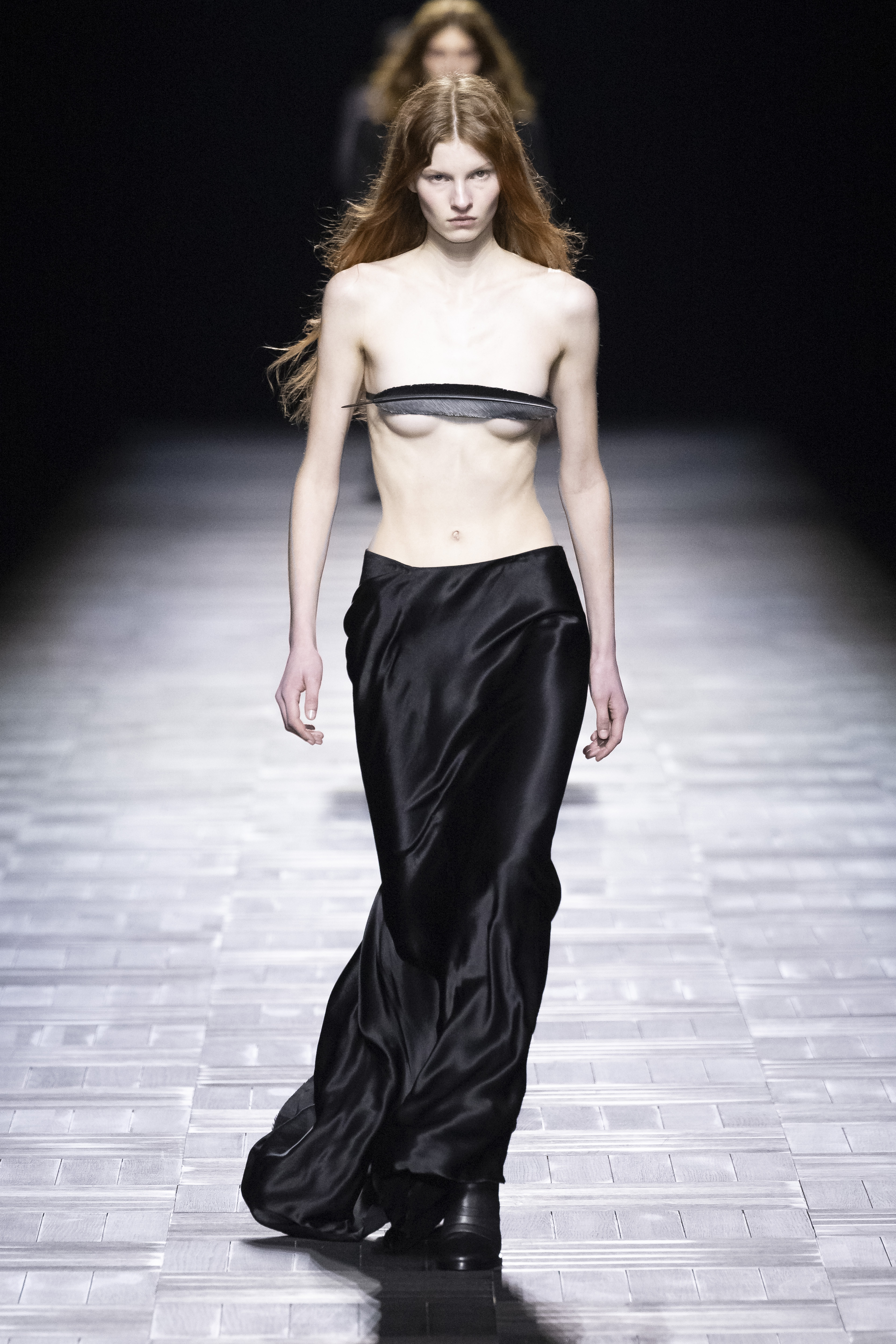
Ludovic de Saint Sernin said that his debut collection at Ann Demeulemeester – the brand originally founded by its namesake in Belgium in 1985 – was an exploration of ‘authorship and autobiography’, a literary analogy that the young designer extended to the collection’s looks. Each one, he said, ‘was a heartfelt sentence… ideally written with a quill, or a feather: a detail Ann loved.’ Indeed, the feather appeared in the collection’s opening look; crafted from leather, it doubled as a narrow black bra top that ran across the model’s chest (a white version closed the show). The idea of exposure has been explored in Saint Sernin’s work at his eponymous label – he will often feature underwear, or entirely sheer garments, in his collections – here melded with riffs on Demeulemeester’s archive for a stripped-down take on the brand infused with ‘sensuality, silhouette, ambiguity’. ‘Writing a letter is always about the sender just as much as it is about the receiver. It’s an encounter, an exchange,’ said the designer of the anticipated debut. ‘It’s an intro, a preamble, and as such, to be continued.’
Hermès
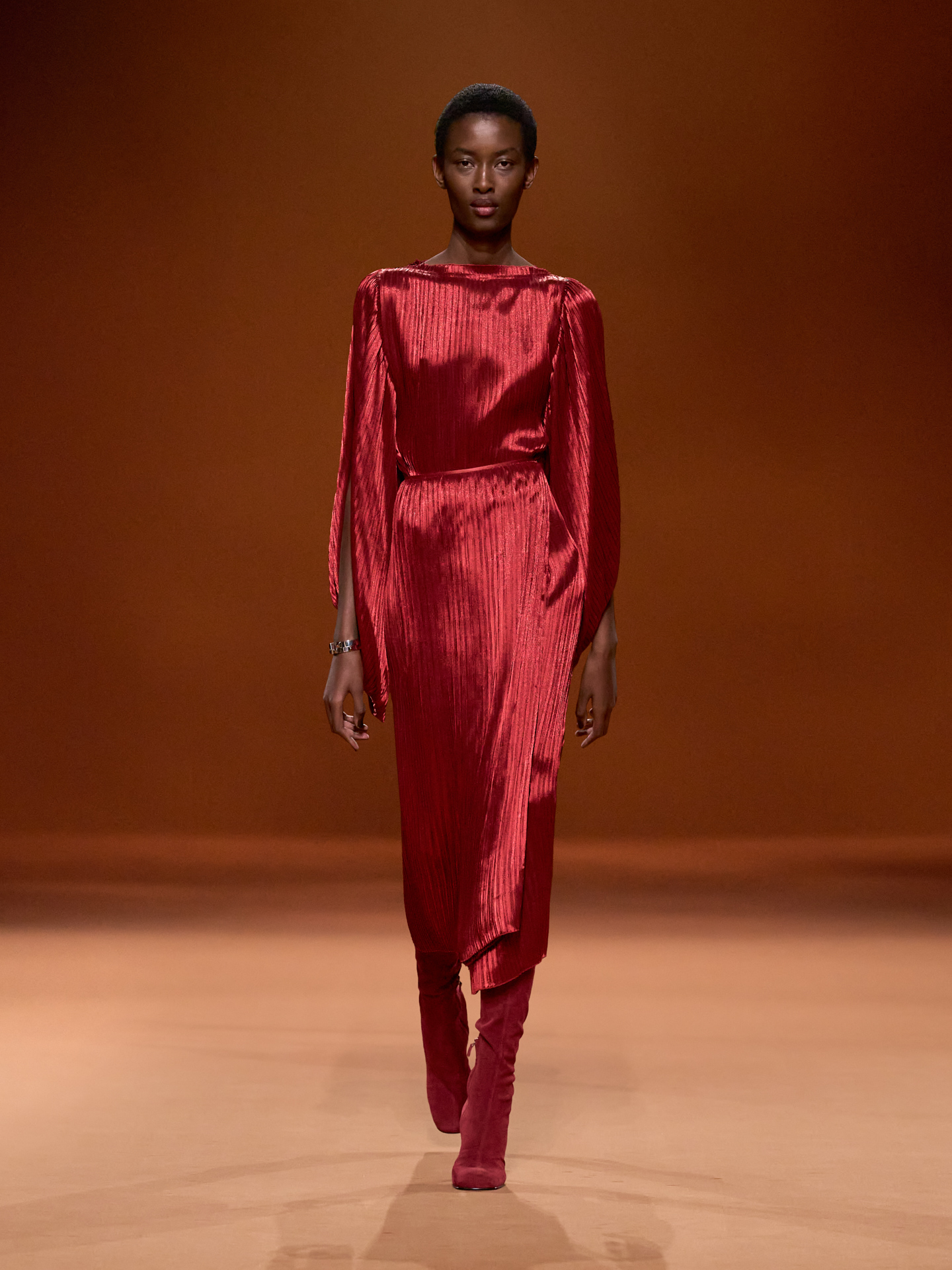
Hermès A/W 2023
Sensuality infused Nadège Vanhee-Cybulski’s latest collection for Hermès, which she noted was about attempting to capture a feeling of warmth – a mood echoed by the show space, carpeted in deep orange, which had a cocooning effect. The collection began with the designer thinking about hair (Vanhee-Cybulski had cut her own red locks into a bob since last season), particularly in the palette, which spanned shades of red (‘amaranth, falun and fire’), copper, brown, gold and ‘blond’ beige. Oftentimes, these colours made up the entirety of a look – ‘enveloping and warm, monochrome silhouettes unfold in their winter tones,’ said the collection notes – all the way down to the accessories, including the over-the-knee square-toed boots and satin riding caps which recurred throughout. A rich coalescence of texture defined the collection: shearling overcoats had been cleverly trimmed to give the appearance of fur, beautiful belted trench coats were cut from alpaca wool, while gently shimmering lamé knits lent a subtle glamour. The collection closed on a slew of plissé dresses – perhaps the collection’s highlight – which draped elegantly across the shoulders and sleeves. It made for a collection that spoke to Vanhee-Cybulski’s innate understanding of the intimacy of clothing – one not unlike the relationship one has with their hair. ‘From lanyards to tresses, the clothes come alive, bobbing and flowing with the suppleness of locks of hair.’
Andreas Kronthaler for Vivienne Westwood
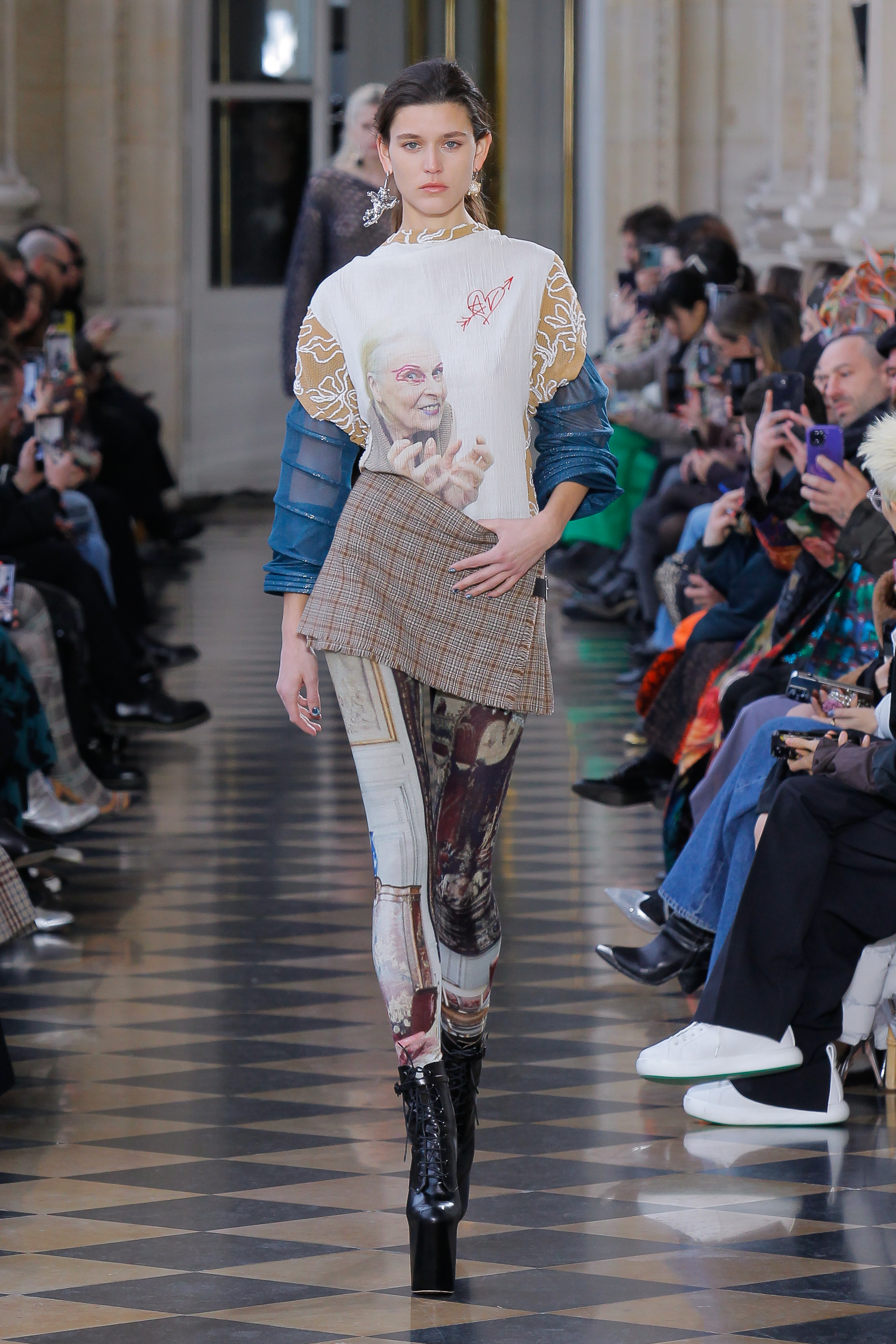
Andreas Kronthaler for Vivienne Westwood A/W 2023
An intimate salon-style presentation – attended by the brand’s close circle of friends, muses and family – marked the first show since the death of Vivienne Westwood in December of 2022. The designer’s inimitable presence was felt throughout the collection’s looks, which saw husband Andreas Kronthaler draw on memories of her life – in particular, her roots in the north of England (Westwood was born in Tintwistle, near Derbyshire; a private funeral was held there in January). ‘In everything we show, I thought of you and where you came from,’ said Kronthaler, who presented garments rich in Westwood-isms – slashed-away tartan, Rococo-style prints and brocade, corsetry, crinolines, tweed tailoring and petticoats all featured in Kronthaler’s usual eccentric amalgam. Of the latter, he said: ‘petticoat skirts were your absolute favourite… I’ve made some for you, all different, so pretty, so girly, so really woman.’ In an emotive gesture, Westwood’s granddaughter, Cora Corré modelled the collection’s final look: a white lace bodice worn with a pair of tiny sparkling devil horns and a typically towering pair of platform boots. ‘You once said to me that you can take everything away, just leave me my platform shoes because one can’t do without them,’ Kronthaler said. ‘Maybe the most important thing you ever taught me was to put the woman on a pedestal.’
Loewe
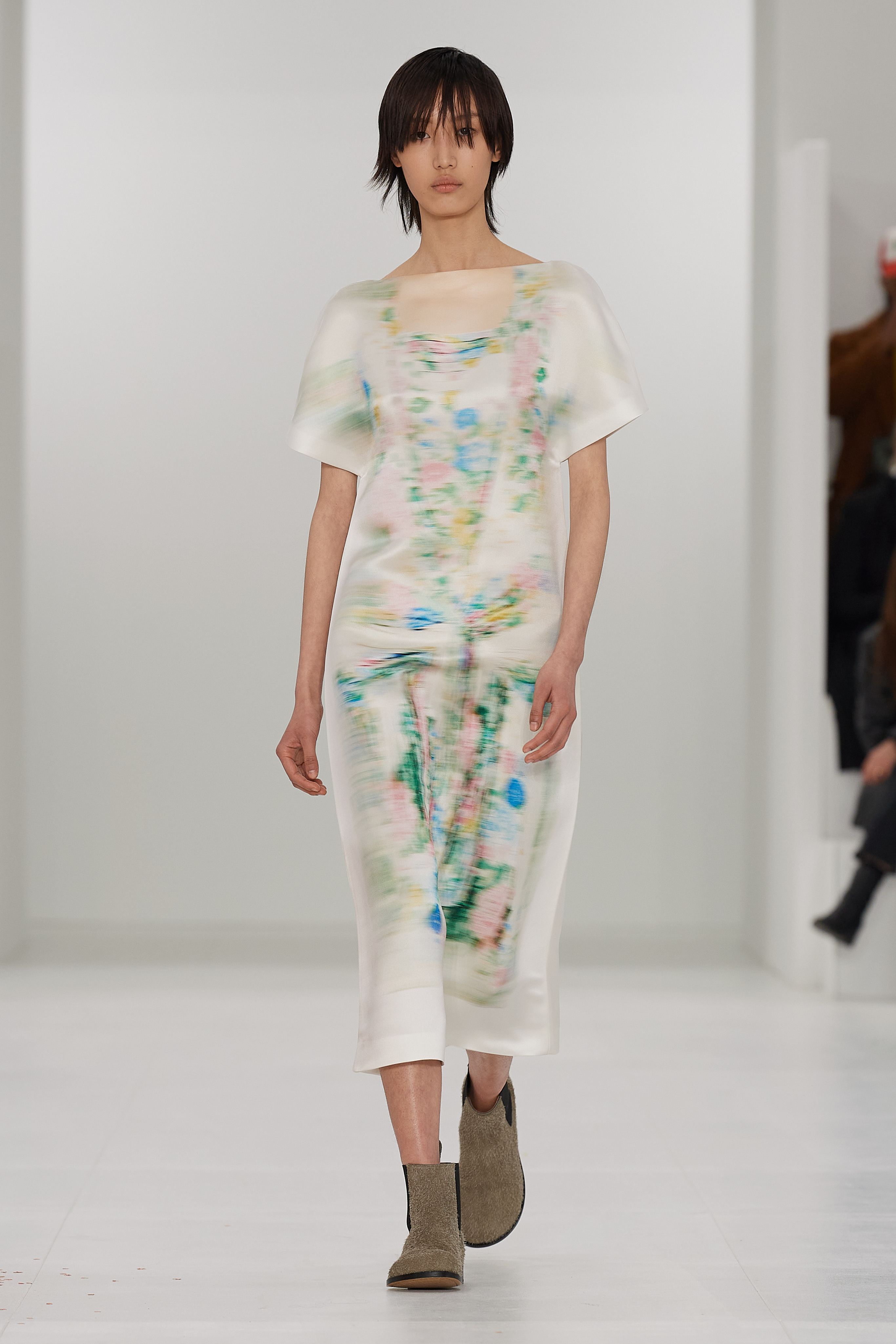
Loewe A/W 2023
Jonathan Anderson’s latest show took place on the eastern edge of Paris in Château De Vincennes, a grand royal residence first built as a fortress in the 12th century and known as a place of sanctuary thanks to its fortified walls. Within those walls, a vast white box had been erected in the central courtyard providing the show space; inside, more boxes in various colours by Italian artist Lara Favaretto, compressed blocks of confetti created in the same process as stomping grapes to make wine. Such was their construction, each came with its own guard – should they be touched, they threatened to disintegrate entirely.
If not intentional, such a frisson – construction versus deconstruction, perfection and collapse – seemed an apt metaphor for Anderson’s work, which has long teetered on such boundaries. Recent collections at Loewe and JW Anderson have seen a move from surrealism to reductionism in an attempt to distill the essence of his work into its purest form; this season, the designer said, continued this movement with a collection that captured ‘an idea of elementality: one piece, and that’s it, reduced to the bluntest shape possible’. White shift dresses – cut with blunt precision – were printed with blurred Gerhard Richter-style apparitions of other garments from previous seasons (‘a memory that fades or returns’); other pieces had a trompe-l’oeil effect to appear creased or distorted (like one fitted cardigan, which after the show Anderson revealed was actually a sticker). Vivid simplicity defined others: a doll-like flared mini dress came in moulded leather, classic V-neck sweaters and cardigans with gently warped silhouettes, while other garments appeared like a piece of fabric had been picked up and held onto the body by its wearer. ‘[I was thinking about that] childhood thing of wrapping yourself up in a duvet,’ he said.
‘It’s the idea of looking at realities – that in the room it looks like one thing, then we have an audience online that sees it a different way,’ Anderson explained of his pursuit for visual clarity. ‘I think it’s about: how do you get newness when you go in store? It’s my greatest obsession at the moment – how do you make collections that are not for right now but in six months? How do you reinforce a language but not get trapped by a language that you built?’
Victoria Beckham
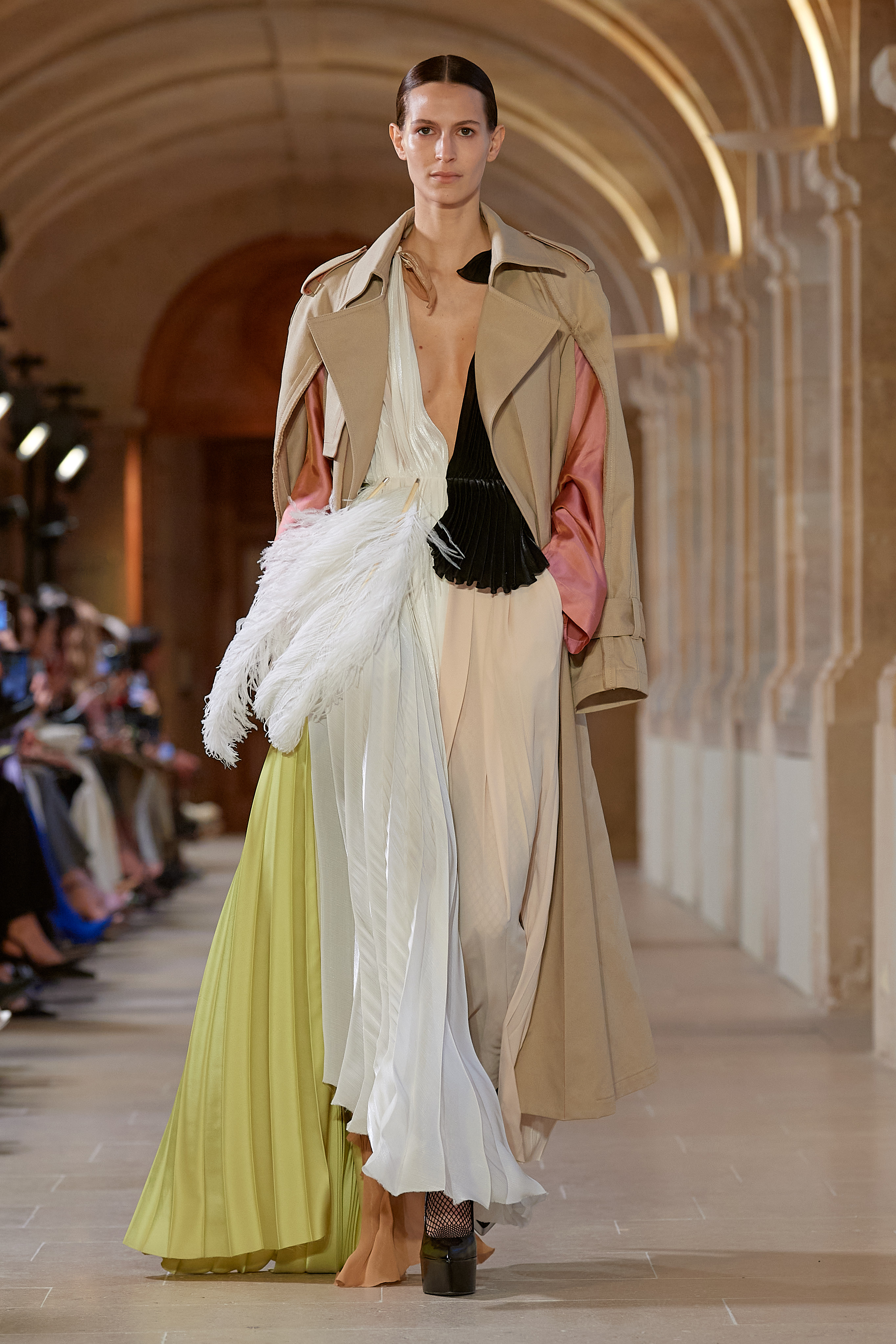
Victoria Beckham A/W 2023
The invitation for Victoria Beckham’s sophomore Paris show – presented once again in the cloisters of Val-de-Grâce church – featured a photograph of actress Drew Barrymore in a silk head scarf from the brand. The look, Beckham said, was a contemporary reimagining of Barrymore’s role as Edith Bouvier Beale (‘Little Edie’) in the 2009 movie Grey Gardens, based on the 1975 documentary of the same name – an exploration of the eccentric, reclusive lives of Bouvier Beale and her mother, two relatives of Jacqueline Kennedy Onassis. The reference, Beckham said, was a perennial influence on her work; here, she said it was the ‘unpredictable glamour’ of Little Edie which inspired a collection rooted in a new eclecticism for the brand, one of ‘deconstruction, customisation and subversion’. As such, the opening looks featured dresses in a collage-like assemblage of pleats and adorned with feathers (later, these same feathers reappeared as a ghostly print in a final series of looks), while other gowns featured elements of faux hair emerging from their hemlines – a nod, Beckham said, to Brazilian artist Solange Pessoa, who utilises human hair in her works. Deconstructed tailoring, meanwhile, was ‘raw and hacked up’, revealing the process behind its construction for a ‘figurative expression of the brand’s artisanal evolution’. ‘I really wanted to celebrate the art of dressing and how clothes are truly transformative,’ said Beckham. ‘The way [Grey Gardens] has been interpreted in the collection is very considered. The result is an eclectic, elegant and sophisticated character, as seen through a modern Victoria Beckham lens.’
Kiko Kostadinov
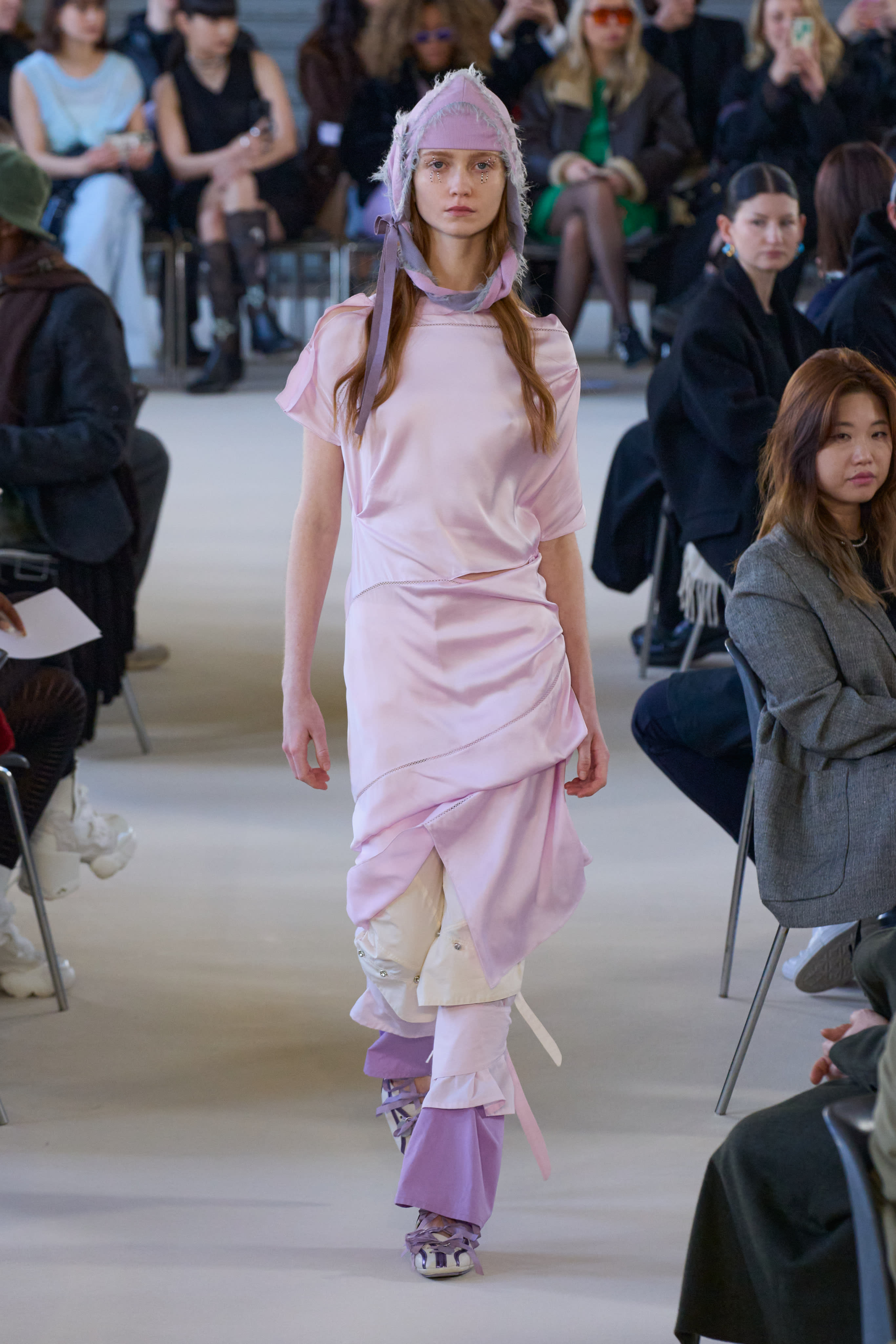
Kiko Kostadinov A/W 2023
A typically eclectic outing from sisters Laura and Deanna Fanning began with research on antique underwear – undershirts, petticoats, knickerbockers – the ‘hidden layers’ which provided the support for women under historical gowns and mantles. Here, these tropes were melded with the Fanning sisters’ eye for off-kilter silhouettes and unexpected colour combinations (in part derived from Kiko Kostadinov’s work at the menswear arm of his eponymous label) for a collection they called ‘a veritable floriège of the unfamiliar, both tough and tender’. Henley-style T-shirts – reminiscent of undergarments – were cut with a wavy layered hem trimmed with narrow ruffles, while a profusion of plissé tulle lent romance to skirts and slip-style dresses, as well as adorning what the duo called ‘stovepipe flares’ (their layered form lent them the feeling of a cargo pant). Accessories provided playful adornment: a ‘bowling/driving/ballet shoe pastiche’ paid ode to Formula One driver Lella Lombardi, while the signature Trivia bag (a recurring street-style staple) was reimagined as both a larger chain bag and miniature charm wallet – no doubt satisfying the brand’s growing legion of devoted followers.
Issey Miyake
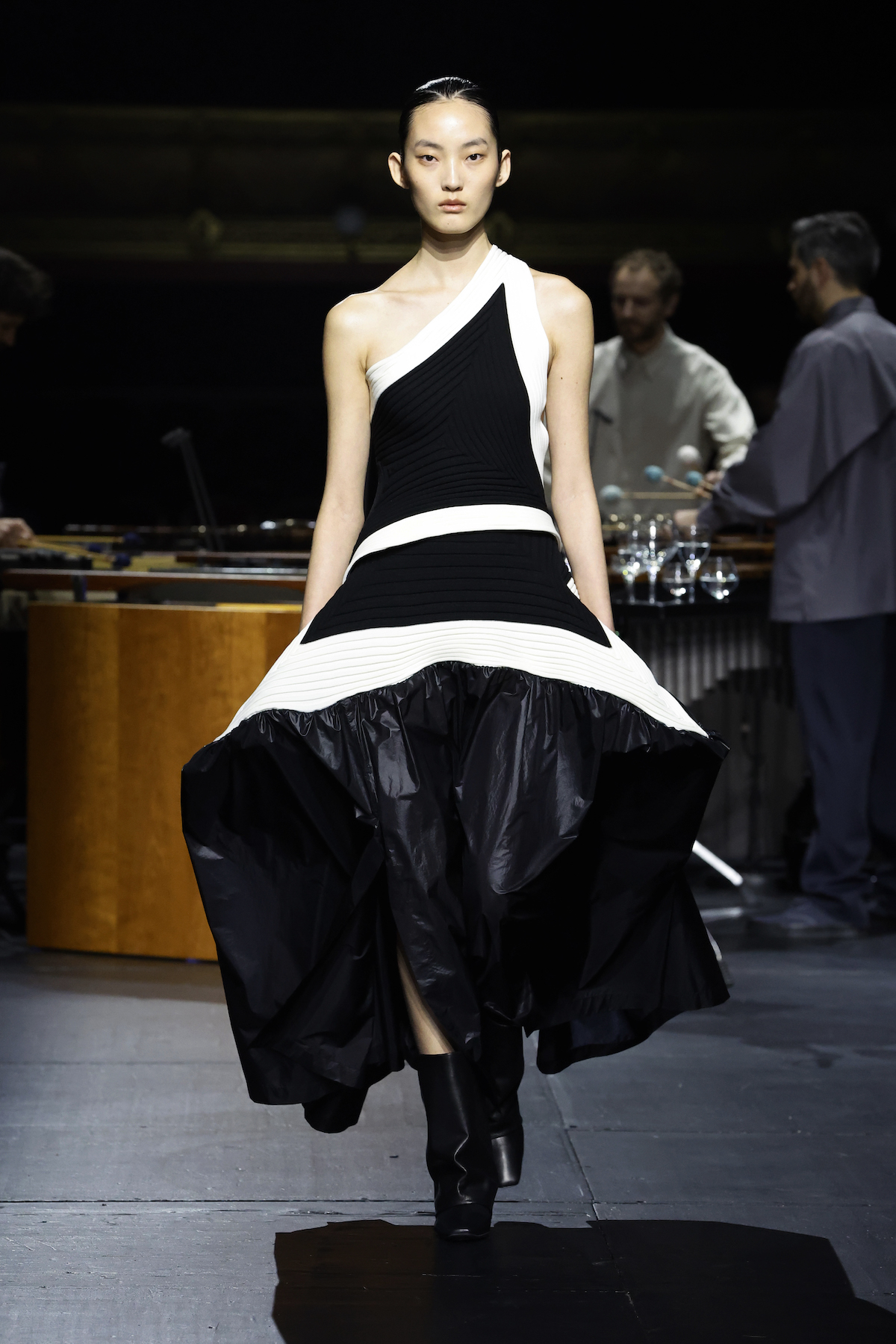
Issey Miyake A/W 2023
An intricately folded square of paper lay on each attendee’s seat at Théâtre du Châtelet, the location for Satoshi Kondo’s latest show for Issey Miyake. The gesture was a nod to the collection’s roots in the shape (its title was ‘The Square and Beyond’), using it as a starting point for a typically innovative exploration of form and silhouette. ‘The collection engages with this rational shape and explores beyond to develop garments of striking, unconventional forms,’ the Japanese brand elucidated. As such, compositions of squares appeared as a printed motif across the collection’s asymmetric, irregular garments, while other pieces saw the square rooted in their construction, like repeating checks which were formed in a process of ‘intentional shrinkage’ giving a raised, three-dimensional texture. ‘Progress, turn and bend, meet up, break off, skip, repeat, extend, expand, and rest,’ an accompanying piece of text said of the season’s experiments. ‘Forms and colours, released from the canvas, now speak of freedom with no limit.’
Schiaparelli

Since his installation as artistic director of Schiaparelli in 2019, American designer Daniel Roseberry has successfully modernised the historic Parisian house with haute couture collections that connect Elsa Schiaparelli’s surrealist preoccupations with a contemporary sensuality (they have also gained him a phalanx of high-profile celebrity fans). Yesterday evening marked the designer’s first ready-to-wear outing for the house, ‘a long-planned and critical step in our ongoing revival of Elsa’s house’, said Roseberry.
Seemingly working in reverse, the vastness of his last couture show was swapped for an intimate salon on Place Vendôme with less than 200 guests in attendance (traditionally, haute couture is shown in such a close-knit setting; ready-to-wear tends to be presented in larger spaces). It spoke to a desire to retain the feeling of exclusivity associated with the historic house; indeed, the construction of the various garments – the curved line of an overcoat sleeve, the intricacy of a boned corset, golden embellishments of surreal eyes and noses – would not look out of place in Roseberry’s haute couture outings (and, with prices purportedly in the several thousands, ready-to-wear here is by no means mainstream). Nonetheless, it offered an expansive vision for the house, encompassing denim, padded jackets and tuxedo-inspired tailoring, all with the suggestion of 1980s excess. ‘A wardrobe, yes,’ said Roseberry. ‘But a Schiaparelli wardrobe.’
Rick Owens

Recent seasons have seen Rick Owens look towards the ‘vastness and scale’ of Egypt, where the American designer now spends his winters. ‘Measuring the insignificance of contemporary discomforts against that amount of history comforts me,’ he says of its appeal, taking this season’s collection name from the ancient city of Luxor. It follows the brand’s A/W 2023 menswear collection of the same name shown earlier this year; then, Owens noted there was a ‘bitterness’ to creating a collection as the war continued in Ukraine, though adding that it was fashion’s responsibility remain stalwart and do its ‘sombre best’ in the face of crisis.
The women’s collection had a similar mood: ‘Times like these might call for a respectful formality and sobriety with moments of delicacy as reminders of what is at risk and at stake,’ the designer said, remarking ‘how inspiring dignity in the face of aggression can be’. As such, the collection had a brutal glamour, models towering above attendees on an industrial metal runway that snaked through one of Palais de Tokyo’s interior wings (platform heels were typically vertiginous). The clothes, Owens said, were reduced to ‘the simplest of shapes’: bulbous pads of leather which wrapped around the body, knit dresses sliced to above the thigh and elongated on the sleeves, or sculptural puffer jackets adorned with pink or black sequins (another dress was covered in hundreds of dangling sequins, giving the appearance of feathers).
The soundtrack comprised a new song by Canadian musician Peaches, who became a muse of sorts for the season, at least in spirit. ‘The graphic sexuality in her intelligent lyrics over tight brutal electronic beats helped make a generation of feminist women singers revel in as much sexual control as had been traditionally held by their male musical counterparts,’ said Owens. ’Her scrappy resistance and ferocity is an example more relevant than ever.’
Givenchy
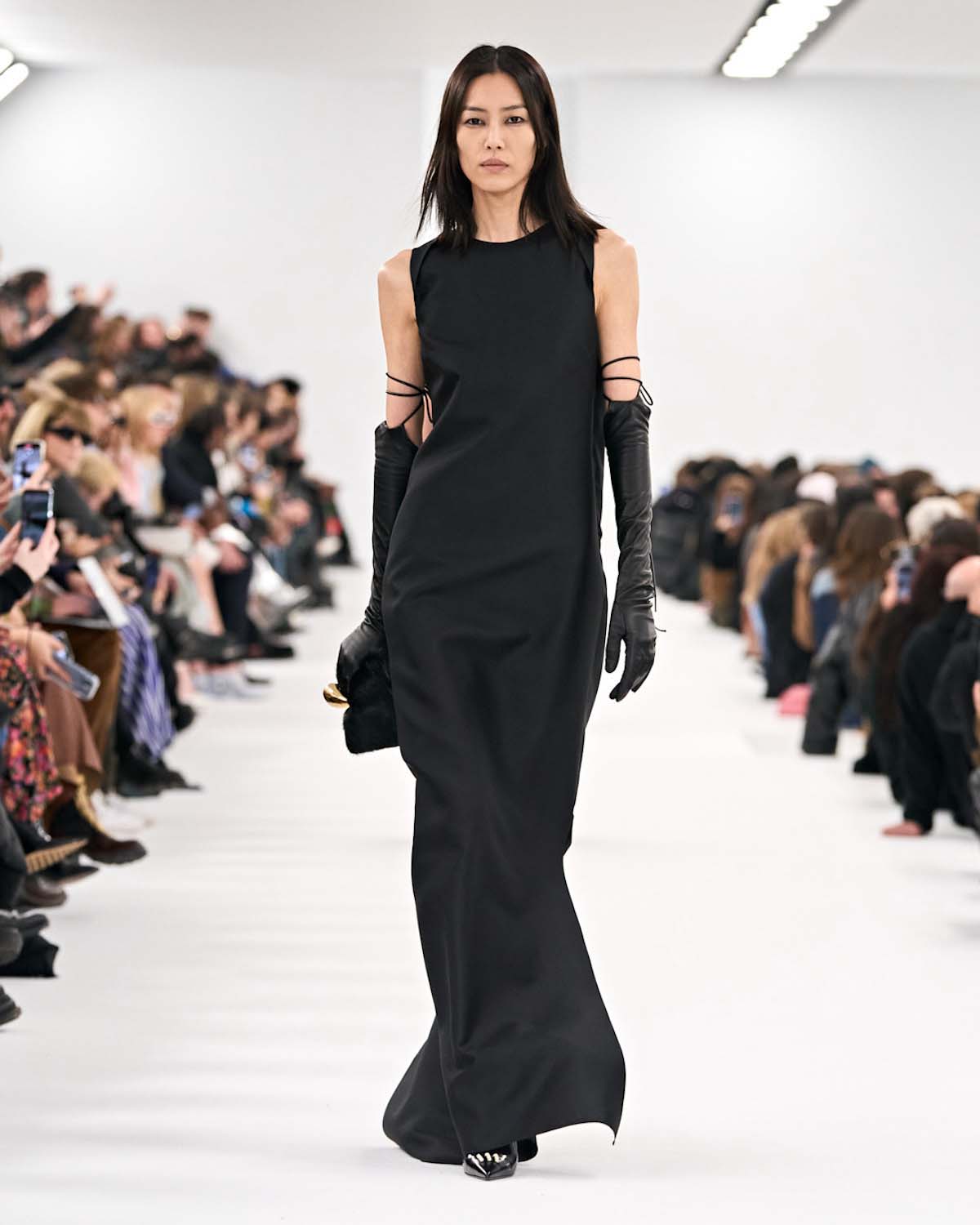
Matthew M Williams continued to hone his vision for Givenchy with a collection that sought the same feeling of clarity captured in his last menswear show in January (the optic-white show space suggested a similar feeling of reset). In that show, Williams talked of a ‘new formality’ which he traced back to Hubert de Givenchy; here, the American designer once again looked towards the house founder and his ‘principles of elegance’. In practice, this made for ‘silhouettes from the past but adapted for the present’: a nipped-waist tailored jacket, for example, might become an abbreviated dress, satin overcoats cut wide across the shoulder for an oversized silhouette, elegant full-length gowns reimagined in contemporary fabrications – from sliced-down-the-front raw-edge leather to sheer body-skimming organza in electric shades of pink and green. Streetwear continued to infuse the collection – its influence, Williams said, was part of ‘the dialogue between Parisian chic and American cool’ that he has noted in recent seasons – in idiosyncratic layers of sweat pants, beaten leather skirts and kilts, some adorned with D-rings and studs. It was likely Williams’ most complete womenswear offering yet, encompassing the ‘confidence, comfort and empowerment’ that the designer said he wanted to capture this season.
Chloé
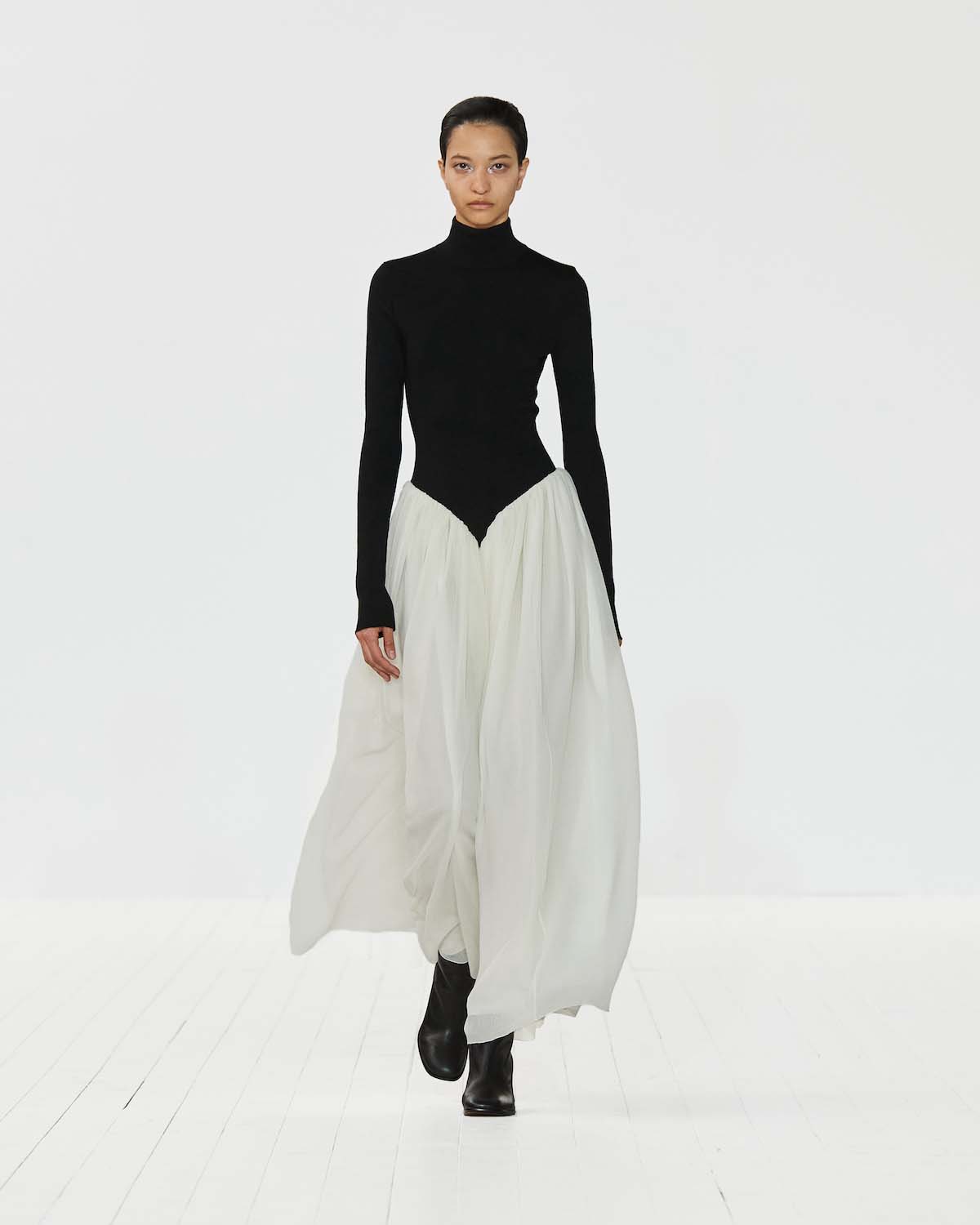
Gabriela Hearst said her latest collection for Chloé drew inspiration from Italian artist Artemisia Gentileschi, a female Baroque painter who was commissioned by the echelons of European society in the 17th century (a landmark exhibition of the convention-defying artist’s work opened in October 2020 at London’s National Gallery). ‘I will show you what a woman can do,’ Gentileschi was quoted as saying on the collection notes, a spirit which informed Hearst’s outlook for the season, embracing the ‘imperative need for women’s stories’. As ever, this was interwoven with the designer’s concerns for the climate, arguing that an increase in women leaders would give new innovation and energy to the field. In keeping with the season’s muse, Hearst noted a Renaissance influence to the silhouettes – a series of tunic-style gowns came with bell or flared sleeves and narrowed at the waist as if held in place by a bodice – here reimagined in black and white, lending a contemporary clarity to the reference. In keeping with Hearst’s sustainable credentials, a low-impact wool gauze was utilised throughout – its ‘ethereal quality a subtle statement of feminine power’ – while other fabrics drew inspiration from Renaissance architecture and highlighted the craftsmanship of the Chloé atelier, like trousers created from an intricate lattice of leather braids or degradé black satin diamonds appliquéd onto wool.
Acne Studios
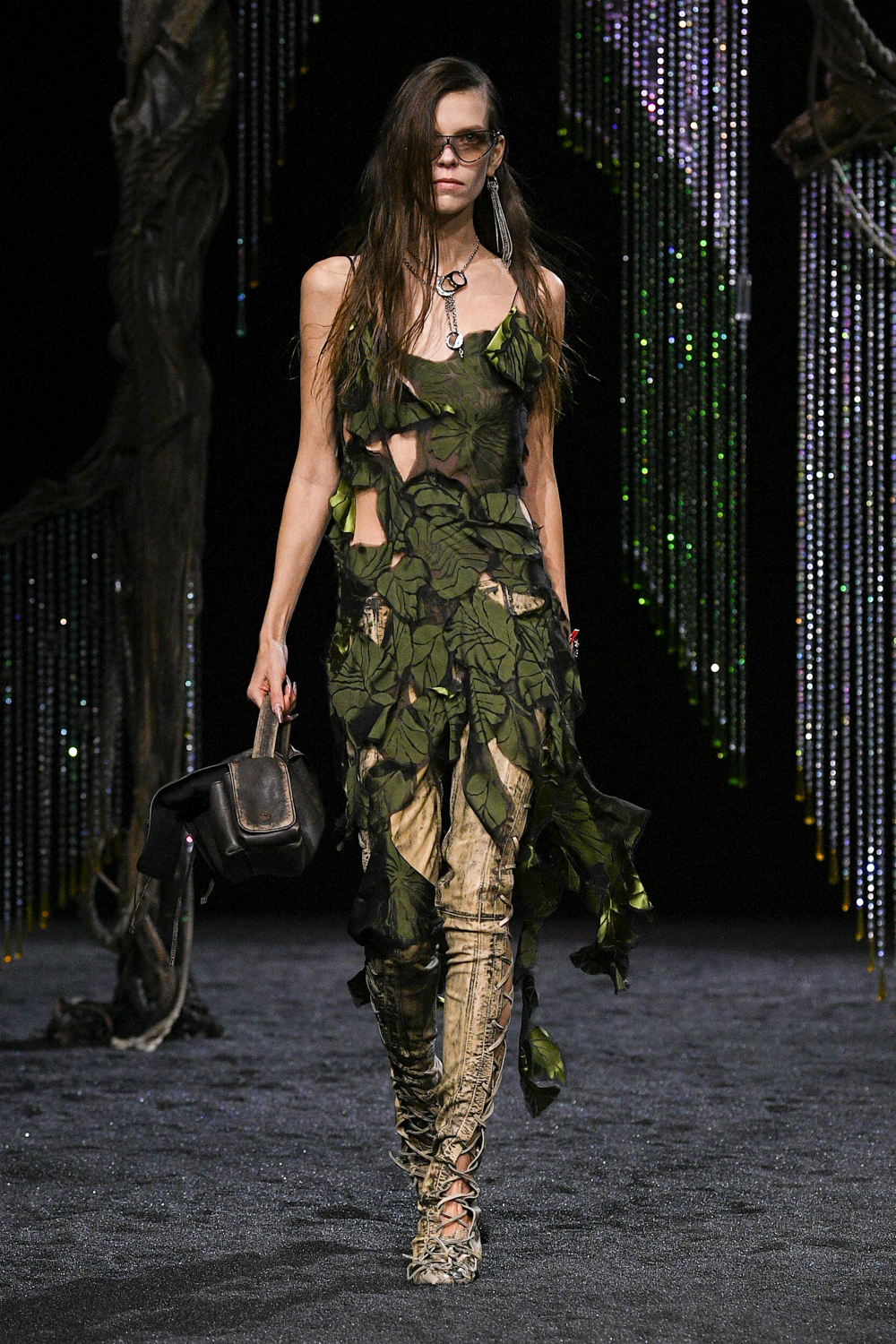
Acne Studios A/W 2023
For his latest Acne Studios collection, creative director Jonny Johansson was thinking about the forest – albeit in the Swedish brand’s typically idiosyncratic style. The show space, created by set designer Shona Heath, evoked the inspiration with a surreal forest of trees adorned with shimmering crystals and strange blooming flora (Johansson said he tasked her to create a space which captured the way a forest is ‘always changing, growing and transforming’). The collection itself reflected the ‘brutal magic’ of the forest and its lore, with elements of distress or decay (several of the pieces had frayed or sliced-away seams), crochet floral adornment and a recurring leaf motif, or the earthy palette, punctuated with ‘toxic’ yellow and pink, rusty orange and a vivid blue reminiscent of Heath’s set. ‘With this collection, I was thinking about the dark winters we have in Sweden, where there are only a few hours of daylight. I wanted to capture the beauty of the darkness,’ said Johansson. ‘Sweden is the kind of place where the city ends abruptly and then the pine forest begins. I’ve always enjoyed the contrast between urban life and nature, the idea that an infinite forest is just around the corner. ‘
Paco Rabanne
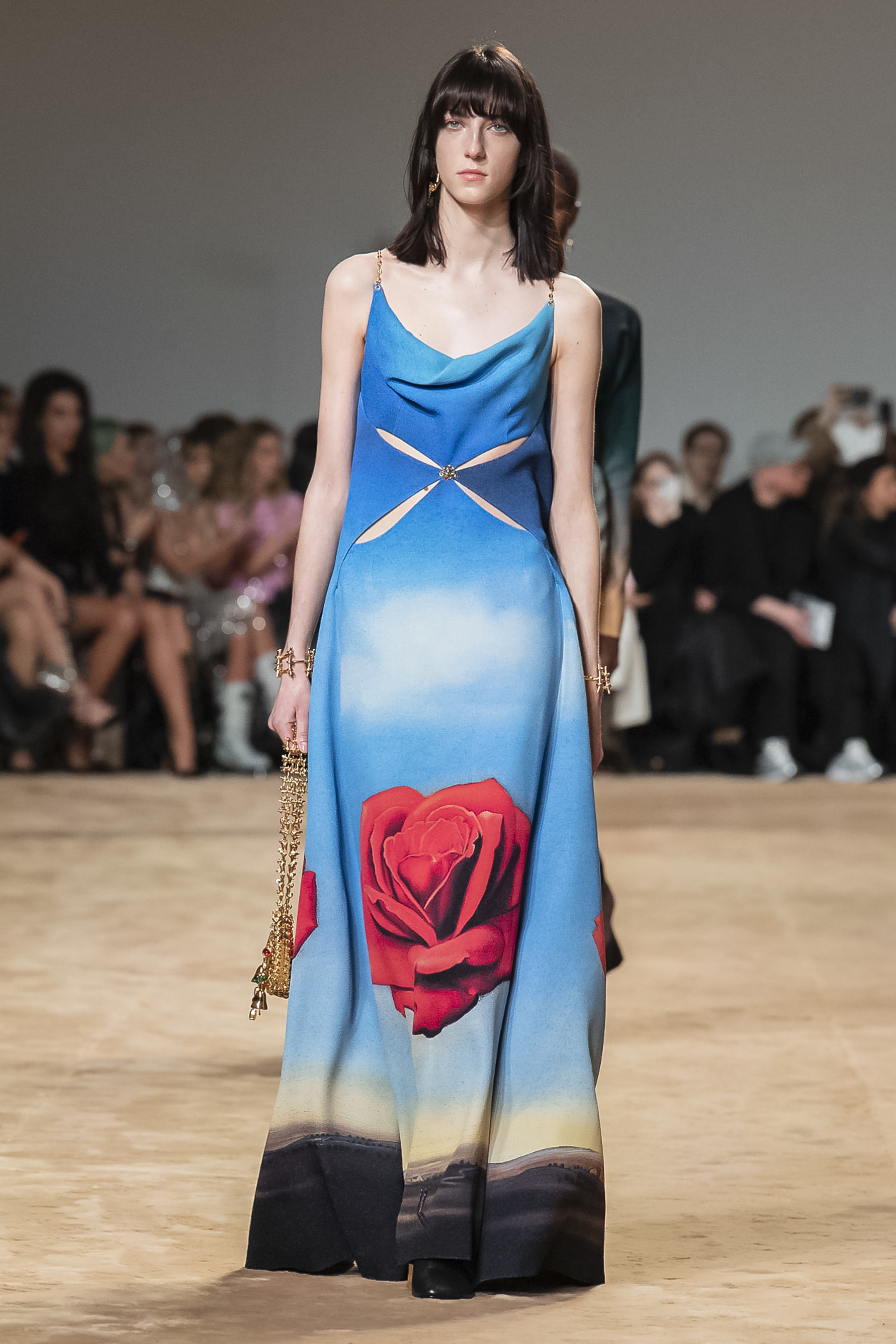
Paco Rabanne A/W 2023
Julien Dossena marked his return to the womenswear schedule – previously he has chosen to show his collections for Paco Rabanne during haute couture week – with a collection which paid tribute to the eponymous house founder who died in February this year aged 88. In particular, Dossena looked towards the friendship between Rabanne and Salvador Dalí – ‘two Spanish visionaries linked by their radical expression… worlds that were at once magical, mystic and mysterious’. As such, the collection featured a series of works by the surrealist artist (with the participation of Fundació Gala-Salvador Dalí), here printed across sliced-away gowns; while motifs reminiscent of his works (like a torn open pomegranate, or a golden telephone) also appeared throughout. Elsewhere, Dossena presented a rich amalgam of texture and embellishment: whether the hairy wool lining of a floor-length overcoat (the appearance was that of fur), shimmering tinsel, or leather melded with the house’s signature diaphanous chain mail. The final five looks were archival creations spanning five decades of Paco Rabanne – a testament, Dossena said, to the late designer’s continuing legacy. ‘These dresses signal the innovative craftmanship that will always define the timeless and totemic women of Paco Rabanne.’
Dries Van Noten
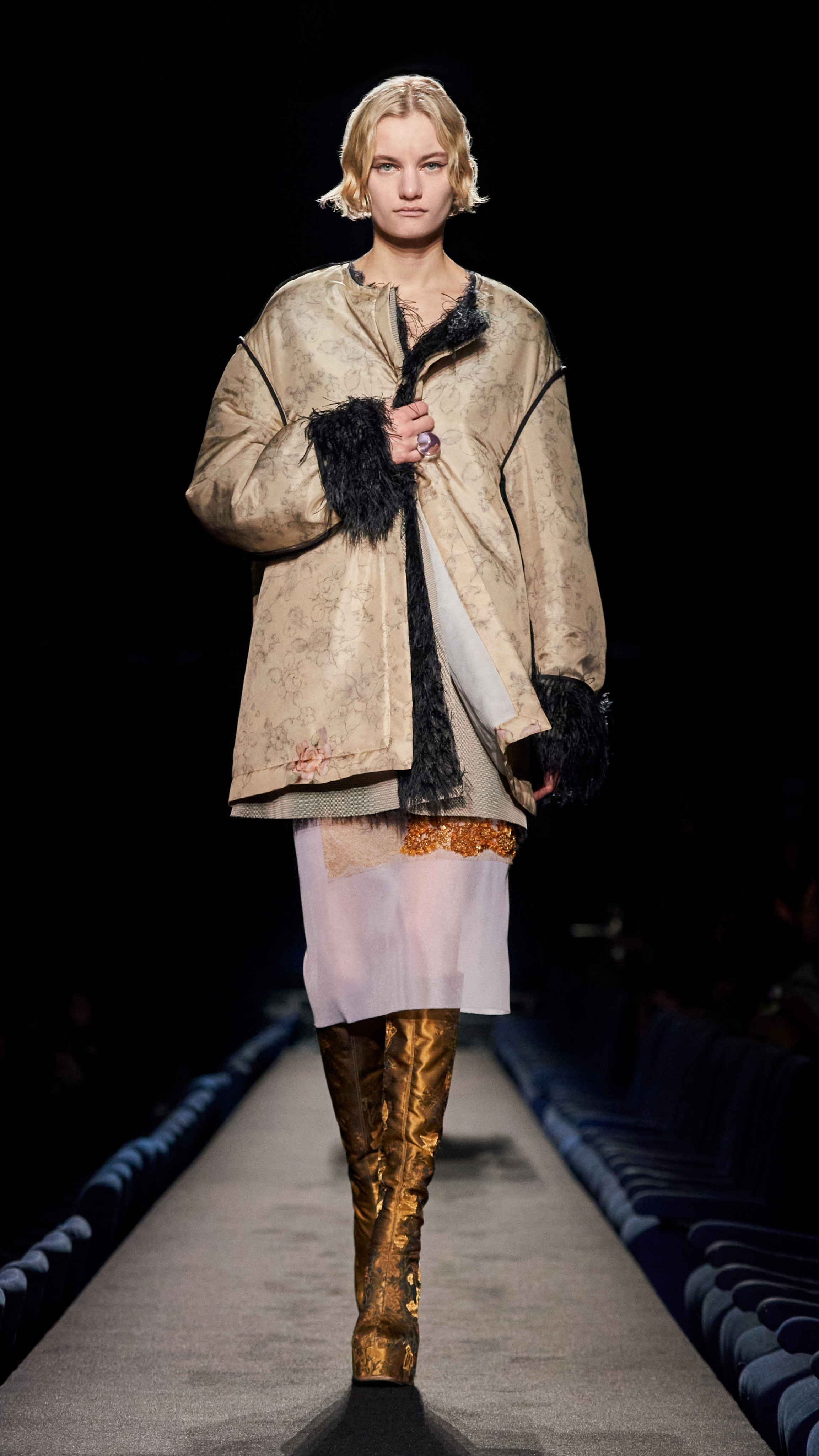
Dries Van Noten A/W 2023
Dries Van Noten’s latest collection came with the simplest of inspirations: ‘the love of clothes… the intimate, tender moments between a garment and its wearer.’ It is an approach which has long defined the Belgian designer’s oeuvre, which has largely eschewed theatrics in pursuit of considered clothing made to exist in the wearer’s wardrobe for decades to come. Though not without gestures of unabashed beauty – Van Noten works with an artist’s eye for colour, form and adornment – figured here in a series of evocative juxtapositions: ‘large-scale gestures mixed with a focus on the small details… the precious and rarefied with the raw and unrefined,’ as the collection notes described. As such, there was a faded grandeur in layers of washed silks, patchwork brocade, or the raw and undone seams (one floral skirt and dress with hanging threads appeared as if viewing a tapestry from its underside), a contrast to the languid simplicity of the silhouette. ‘The pleasure of fabrics and the life they take on over the years, cherished, used, repaired and given new meaning for today,’ said the house.
The Row
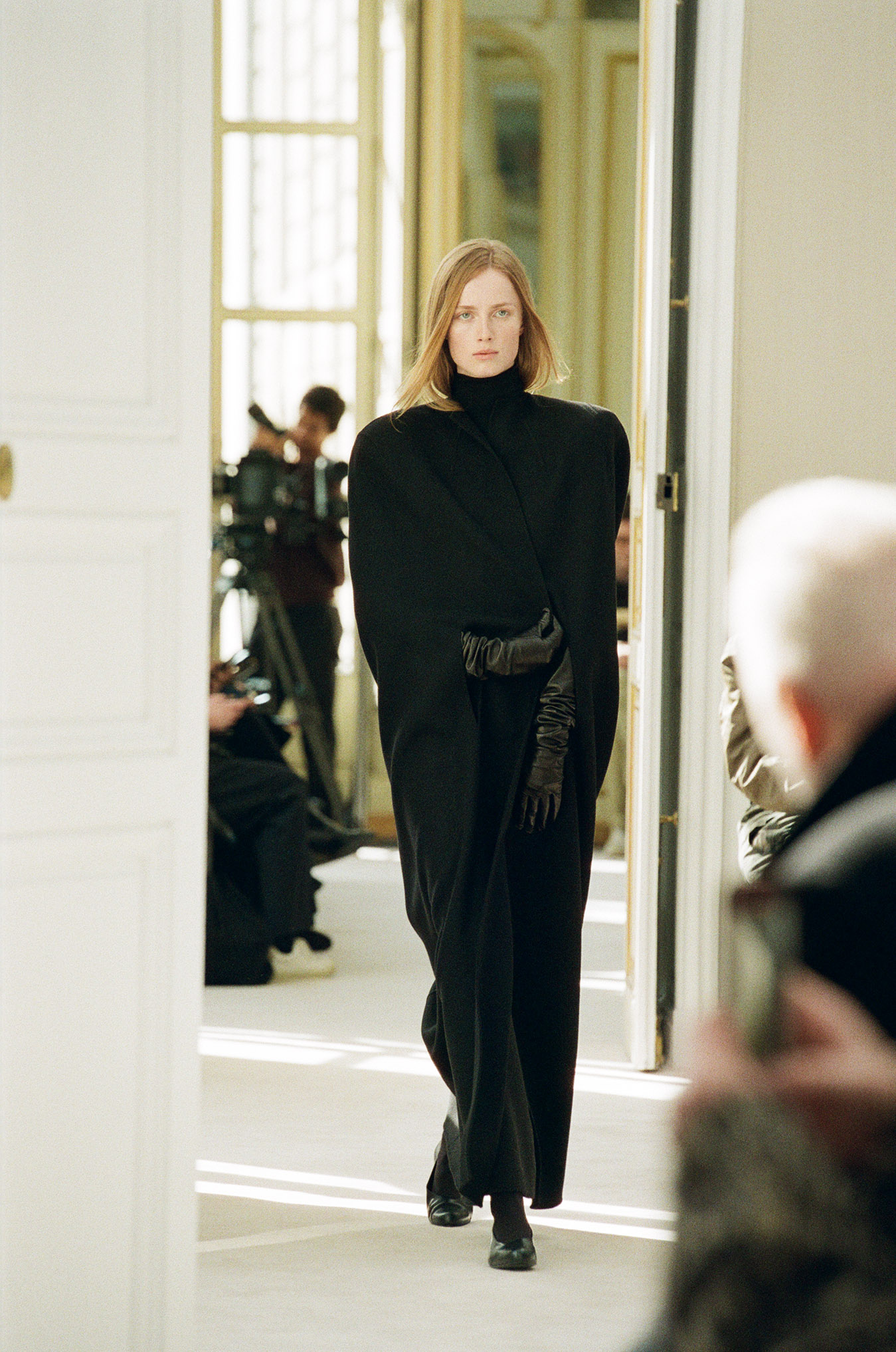
The Row A/W 2023
The considered elegance of Mary-Kate and Ashley Olsen’s The Row extended all the way to the pre-show refreshments: plates of broken-up dark chocolate and piles of pears, each one tipped with a drop of red wax on the stalk. The collection itself – presented in a largely unadorned 18th-century mansion on Rue des Capucines – continued to distil the designers’ vision of discreet luxury, figured here in silhouettes which cocooned the body (scarf- and poncho-like adornments recurred through; overcoats were gripped closed in the hand; tailoring was cut with roomy proportions). A sense of glamour came in wrapped off-the-shoulder black dresses and leather opera gloves, while brief flashes of red and orange interrupted the otherwise restrained palette.
Courrèges
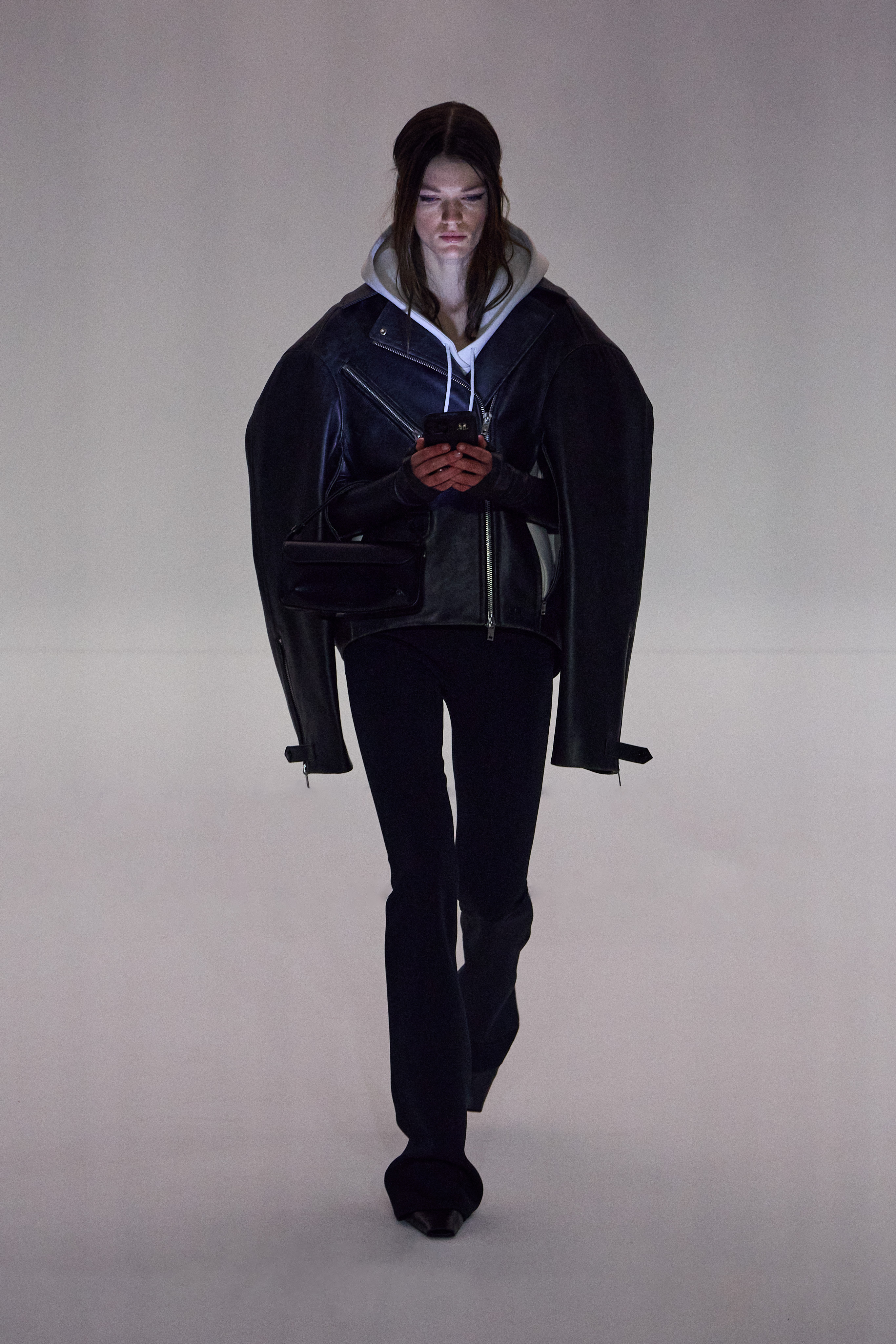
Courrèges A/W 2023
Courrèges creative director Nicolas Di Felice said his latest collection ‘emerged from the curved stance of a body cloaked over a screen’. Indeed, in a now-viral moment from the show – which took place in an optic white box, misted with fog and brightly lit – the first model walked the runway whilst scrolling on an iPhone. The hunched gesture, Di Felice said, informed the collection’s curved silhouette, with garments ‘projecting [their] volume outward to shield the body from the world’ (as such, expansive leather jackets and outerwear were cut wide at the shoulder, their weight tilting slightly forward as if bent over a phone). Soundtracked by a disembodied voice repeating ‘is the sky blue?’, the collection had an air of futuristic ritual in monastic hooded sweaters which cloaked the body and a series of elongated column gowns, worn with vast circular jewellery beneath. ‘A ceremony of light and enlightenment… lighting the way to the other within ourselves,’ described the accompanying notes. ‘Through the dark, through the smoke and mirrors, I see you.’
Saint Laurent
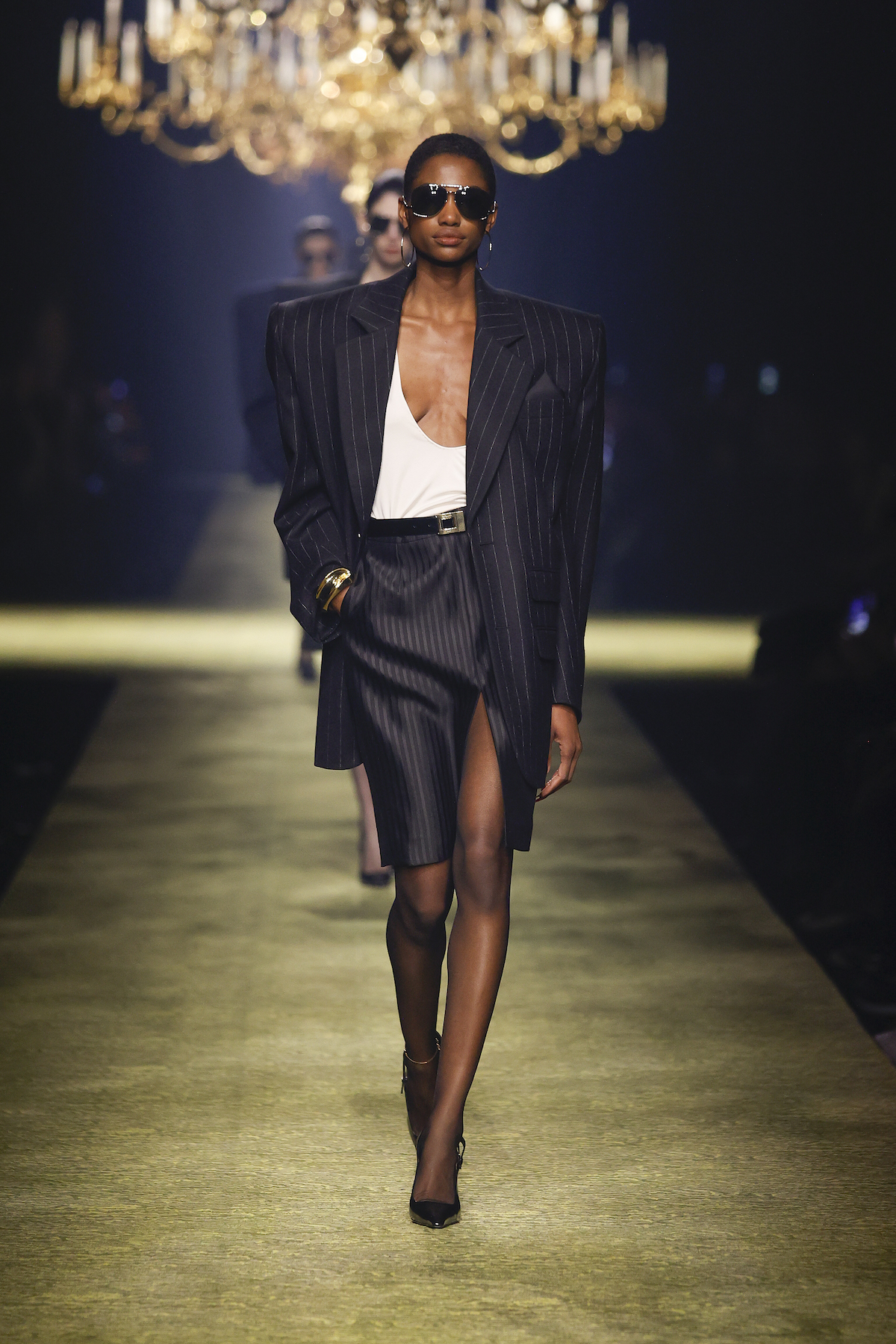
Saint Laurent A/W 2023
From 1975 to 2001, Yves Saint Laurent showed his haute couture collections on a raised runway in the gilded ballroom of the Intercontinental Hotel in Paris; yesterday evening, the house’s current creative director Anthony Vaccarello recreated the space, albeit in a vast constructed showspace on the Trocadéro. ‘Making the reference newly relevant, Vaccarello has taken symbols of the opulent period – striking bronze chandeliers and a uniquely shaped runway – and inserted them into a radically contemporary black-box setting,’ said the house. It provided an apt metaphor for Vaccarello’s tenure at the house, which is defined by drawing elements from the Yves Saint Laurent archive and reimagining them in his own sharply contemporary style. This season, in lieu of a specific inspiration point, Vaccarello instead looked to continue to hone what he called ‘the essence of classic Saint Laurent style… a potent mix of precision, emotion and reticence’.
It made for a severity of cut and silhouette – the opening pinstripe skirt suit came with enormous padded shoulders for a dramatic shape which was reiterated throughout (‘it all starts with this gesture’) – combined with flourishes of glamour, like sweeping blanket-like scarves, pussy-bow collars, and heavy golden bangles and cuffs. A feeling of ‘emotion’, Vaccarello said, emerged in a ‘dissolution of gendered exclusivity’, with archetypically masculine garments (the tailored blazer, the tank top, the leather bomber) embedded into his woman’s wardrobe, while the use of pinstripe, tartans and glen plaids took ‘on a timeless femininity thanks to a striking lightness’. As is typical of Vaccarello’s work, a feeling of sensuality infused the collection; plunging tank tops, sheer hosiery and chiffon layers explored ideas of concealment and exposure. ‘The Saint Laurent woman exposes her body when she desires and conceals it if she feels like it,’ said the house.
Dior
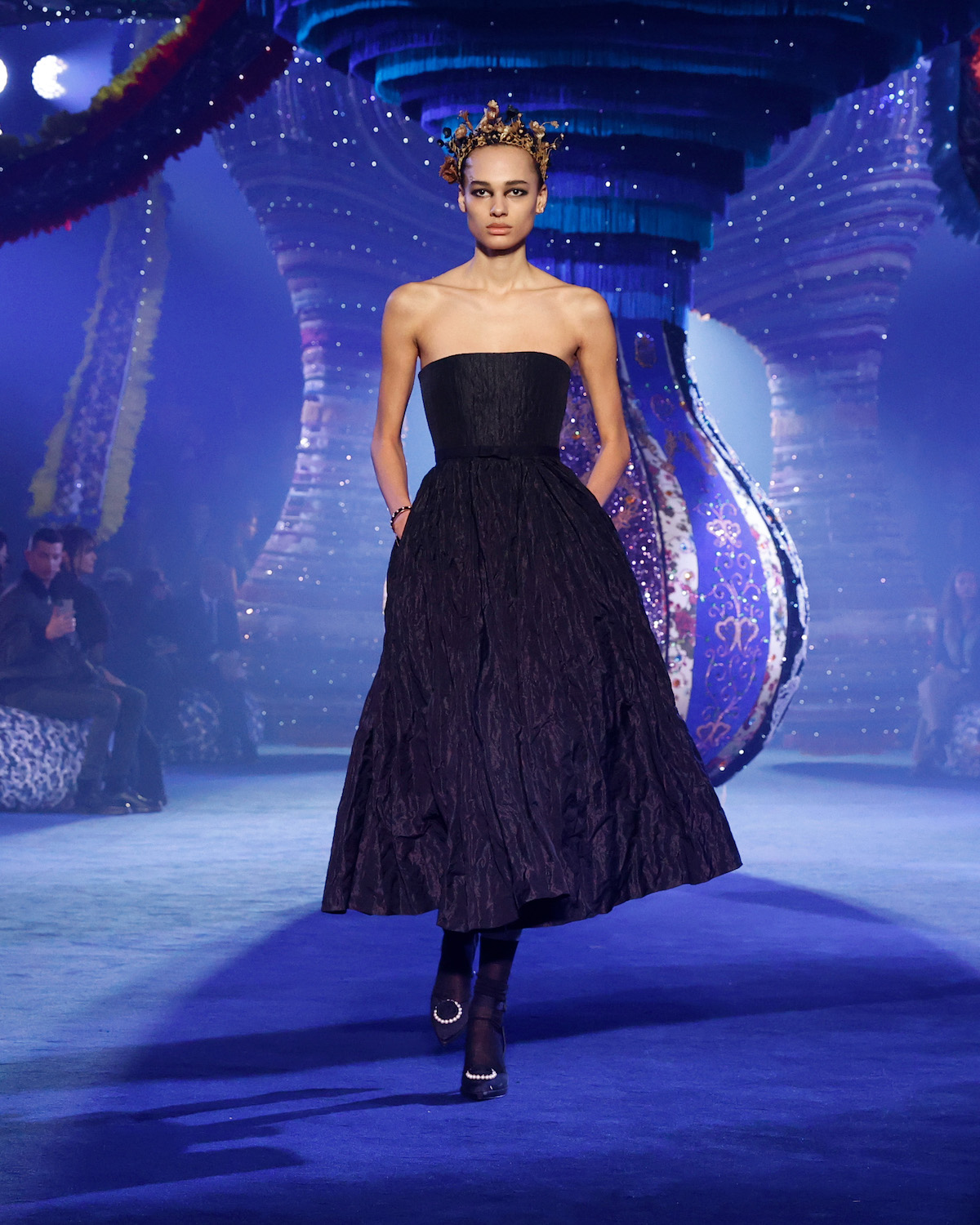
Dior A/W 2023
Maria Grazia Chiuri conjured a mood of femininity for her latest Dior collection, which was backdropped by a vast kaleidoscopic artwork by Portuguese artist Joana Vasconcelos (the carnivalesque work featured lace, embroidery and crochet and was inspired by flowers in the Dior archive; it continues a tradition of Grazia Chiuri collaborating with women artists on her show sets). ‘A re-reading of the 1950s,’ described the house of the collection itself, which begun with Grazia Chiuri looking back to mid-century designs from the house; in particular, she focussed on three women who have become archetypal of French style: Catherine Dior (house founder Christian Dior’s sister, and purported inspiration behind the enduring ‘Miss Dior’ fragrance), Édith Piaf and Juliette Gréco. Each, she noted, subverted feminine dress in their own way; in the collection, this figured in ladylike silhouettes – nipped-waist gowns, flared calf-length skirts and blouses – released from constriction and imbued with new lightness (a feeling of gentle dishevelment came in creased and mottled finishes). The flower also recurred throughout, inspired by Catherine Dior – who sold and traded flowers after her time as a resistance fighter in France during World War II – here reimagined in hazy floral prints and delicate embroidery. ‘At once strong and fragile,’ described the house. ‘This Dior collection is the very signature of a femininity that goes against the grain.’
Stay tuned for more from Paris Fashion Week A/W 2023.
Jack Moss is the Fashion Features Editor at Wallpaper*, joining the team in 2022. Having previously been the digital features editor at AnOther and digital editor at 10 and 10 Men magazines, he has also contributed to titles including i-D, Dazed, 10 Magazine, Mr Porter’s The Journal and more, while also featuring in Dazed: 32 Years Confused: The Covers, published by Rizzoli. He is particularly interested in the moments when fashion intersects with other creative disciplines – notably art and design – as well as championing a new generation of international talent and reporting from international fashion weeks. Across his career, he has interviewed the fashion industry’s leading figures, including Rick Owens, Pieter Mulier, Jonathan Anderson, Grace Wales Bonner, Christian Lacroix, Kate Moss and Manolo Blahnik.
-
 Australian bathhouse ‘About Time’ bridges softness and brutalism
Australian bathhouse ‘About Time’ bridges softness and brutalism‘About Time’, an Australian bathhouse designed by Goss Studio, balances brutalist architecture and the softness of natural patina in a Japanese-inspired wellness hub
By Ellie Stathaki
-
 Marylebone restaurant Nina turns up the volume on Italian dining
Marylebone restaurant Nina turns up the volume on Italian diningAt Nina, don’t expect a view of the Amalfi Coast. Do expect pasta, leopard print and industrial chic
By Sofia de la Cruz
-
 Tour the wonderful homes of ‘Casa Mexicana’, an ode to residential architecture in Mexico
Tour the wonderful homes of ‘Casa Mexicana’, an ode to residential architecture in Mexico‘Casa Mexicana’ is a new book celebrating the country’s residential architecture, highlighting its influence across the world
By Ellie Stathaki
-
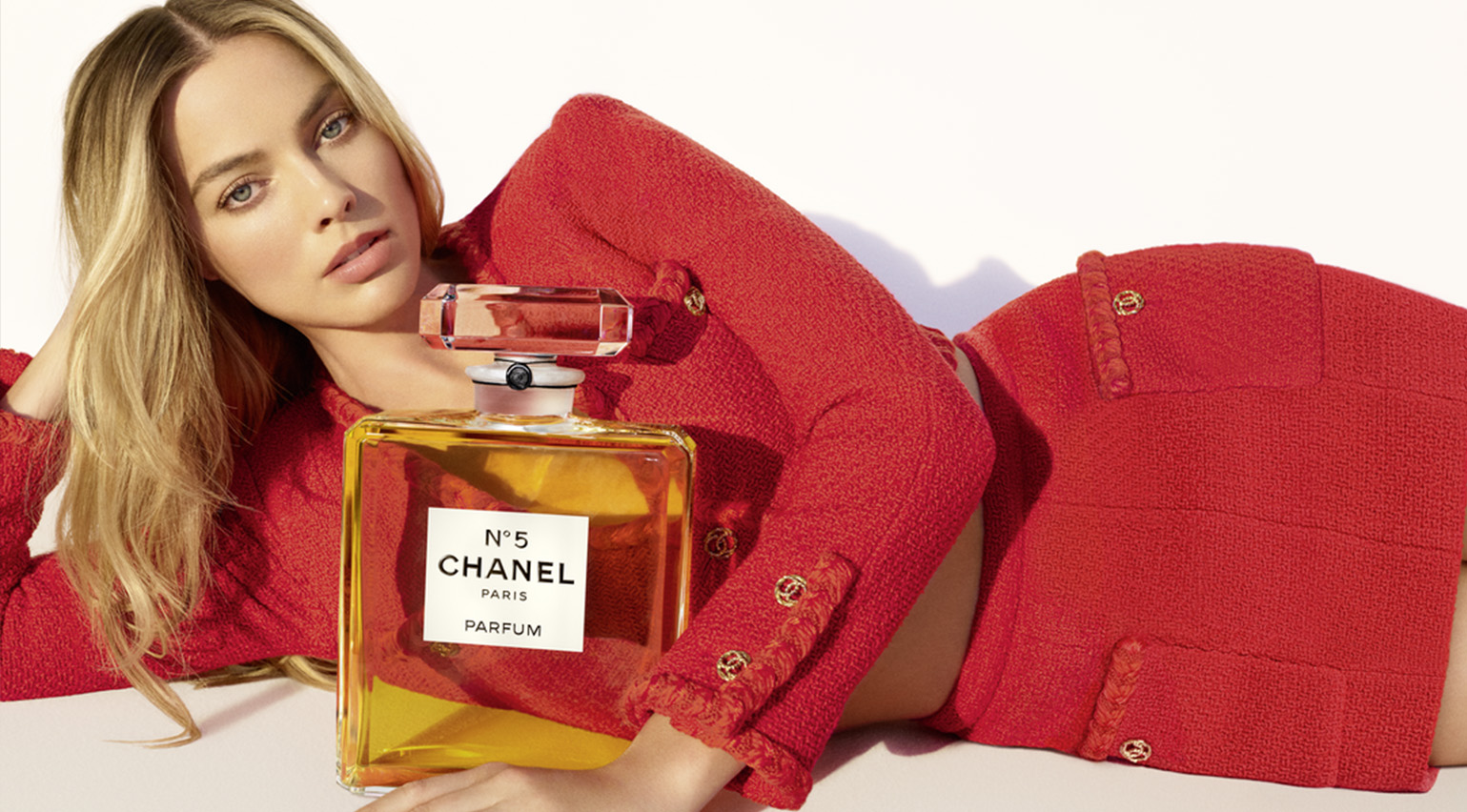 Margot Robbie, Marina Abramović and a 15-step Korean scalp treatment: the most-read Wallpaper* beauty stories of 2024
Margot Robbie, Marina Abramović and a 15-step Korean scalp treatment: the most-read Wallpaper* beauty stories of 2024The news of Margot Robbie becoming the face of Chanel No.5 and an illustrated guide to a 15-step Korean scalp treatment are just two of the most-read Wallpaper* beauty stories from the year gone by
By Hannah Tindle
-
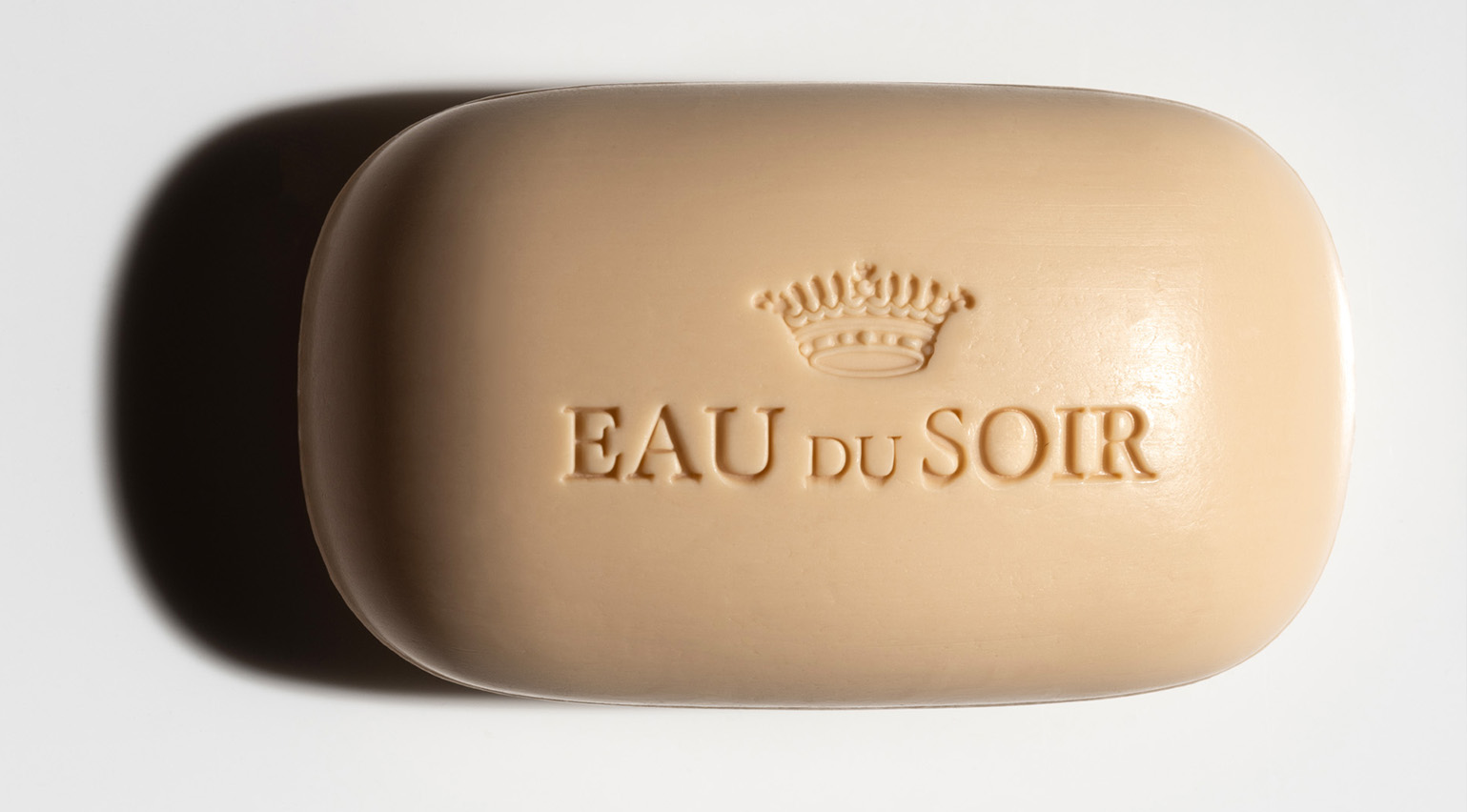 Unboxing beauty products from 2024, as seen on the pages of Wallpaper*
Unboxing beauty products from 2024, as seen on the pages of Wallpaper*Wallpaper's 2024 beauty picks included Chanel lipstick, Bottega Veneta perfume and solid soap from the likes of Aesop, Celine, Diptyque, Hermès and Sisley
By Hannah Tindle
-
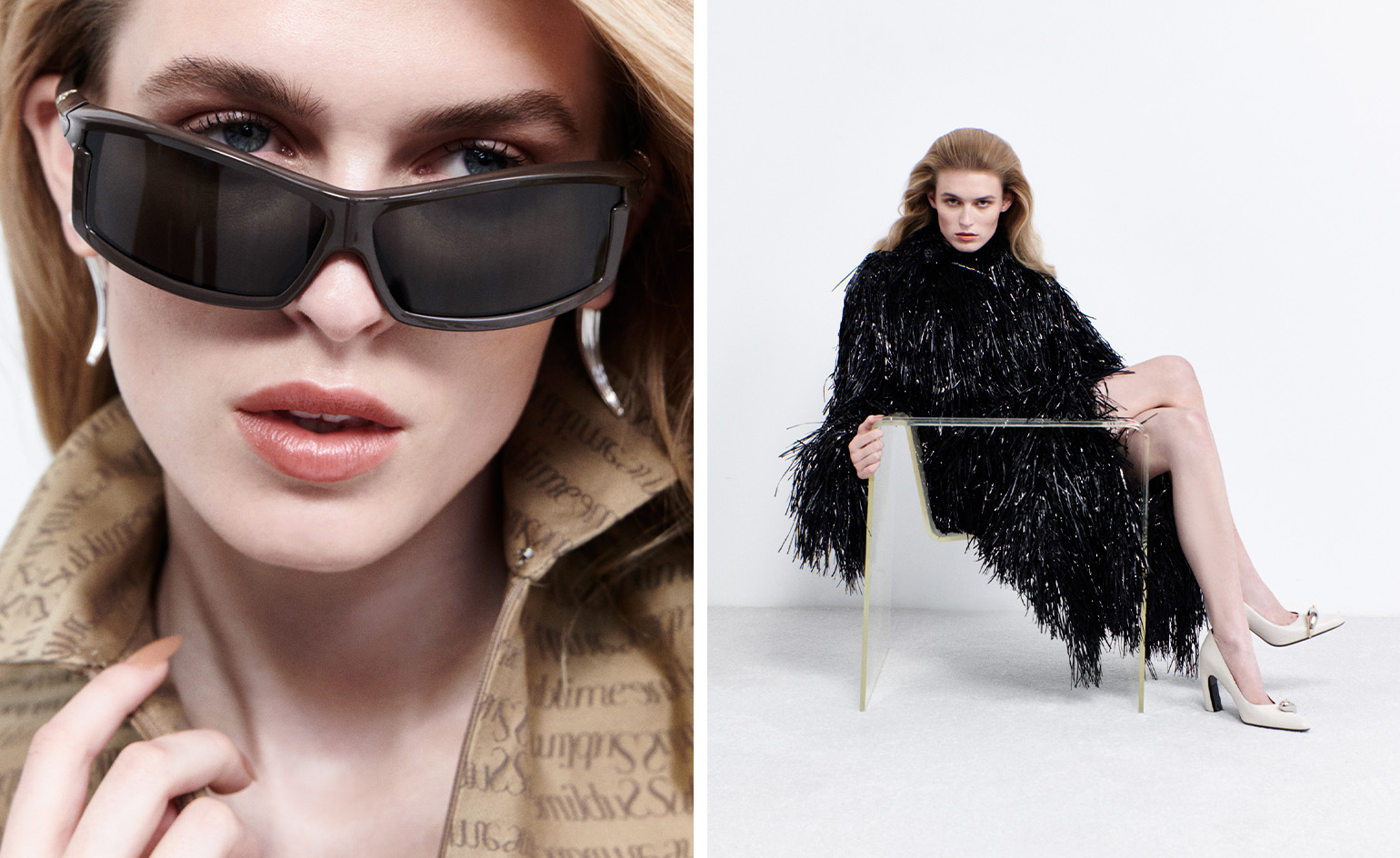 These illuminating fashion interviews tell the story of style in 2024
These illuminating fashion interviews tell the story of style in 2024Selected by fashion features editor Jack Moss from the pages of Wallpaper*, these interviews tell the stories behind the designers who have shaped 2024 – from Kim Jones to Tory Burch, Willy Chavarria to Martine Rose
By Jack Moss
-
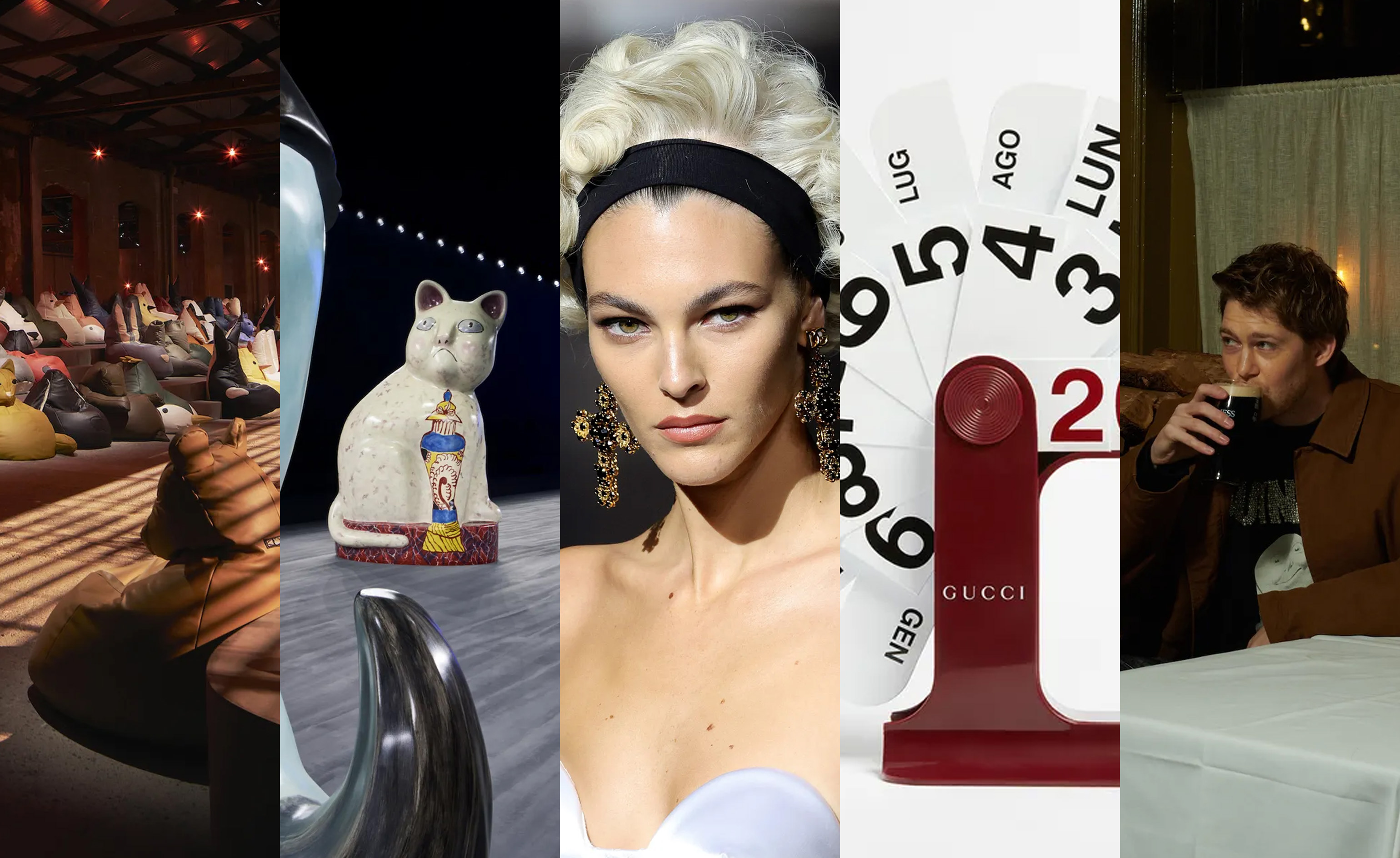 Giant cats, Madonna wigs, pints of Guinness: seven objects that tell the story of fashion in 2024
Giant cats, Madonna wigs, pints of Guinness: seven objects that tell the story of fashion in 2024These objects tell an unconventional story of style in 2024, a year when the ephemera that populated designers’ universes was as intriguing as the collections themselves
By Jack Moss
-
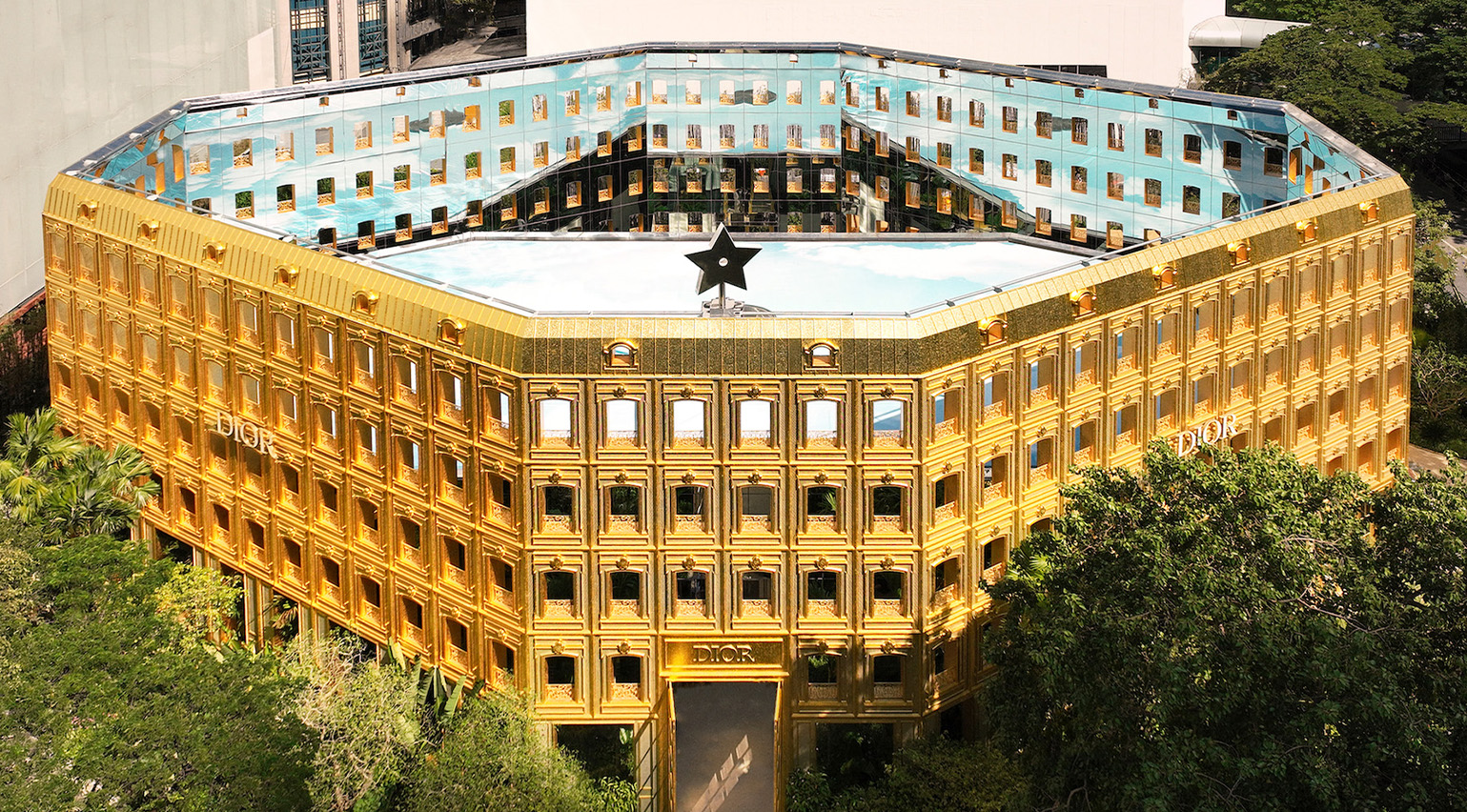 Inside Dior’s ‘Gold House’ in Bangkok, a spectacular celebration of Thai art and craft
Inside Dior’s ‘Gold House’ in Bangkok, a spectacular celebration of Thai art and craftDaven Wu takes a trip to Bangkok to discover ‘Gold House’, a gilded new concept store from Dior which is rooted in both Parisian savoir-faire and artisanal Thai craft, featuring a café, gardens and showstopping gilded facade
By Daven Wu
-
 ‘He immortalised the birth of the supermodel’: inside Dior’s career-spanning retrospective of photographer Peter Lindbergh
‘He immortalised the birth of the supermodel’: inside Dior’s career-spanning retrospective of photographer Peter LindberghOlivier Flaviano, head of Paris’ La Galerie Dior, talks us through a new Peter Lindbergh retrospective, which celebrates the seminal German photographer’s longtime relationship with the French house
By Jack Moss
-
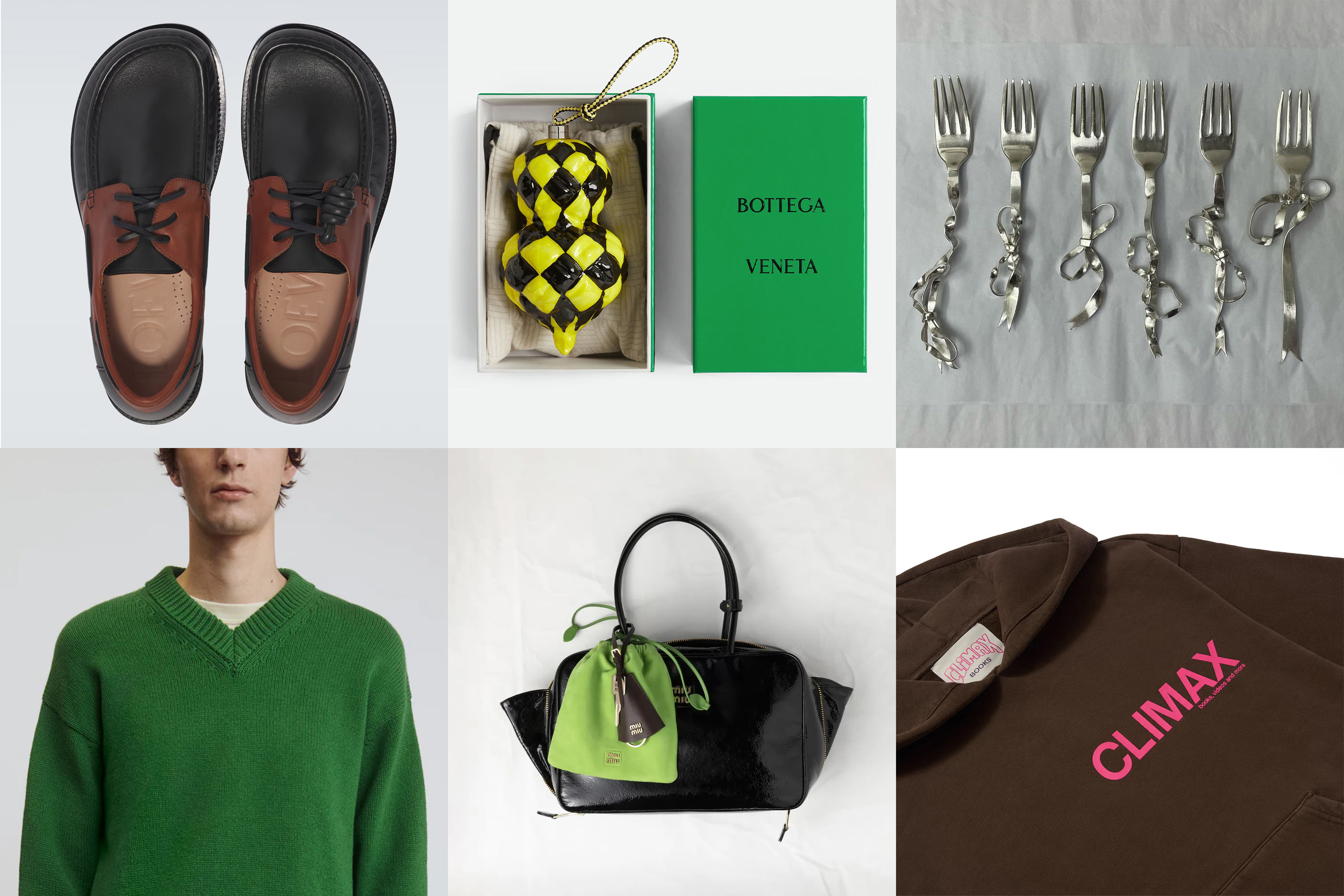 Fashion features editor Jack Moss’ style gift guide
Fashion features editor Jack Moss’ style gift guideWallpaper* fashion features editor Jack Moss compiles his fantasy festive wish list – from a surreal Bottega Veneta tree decoration to Hylton Nel’s Dior-approved ceramic cats
By Jack Moss
-
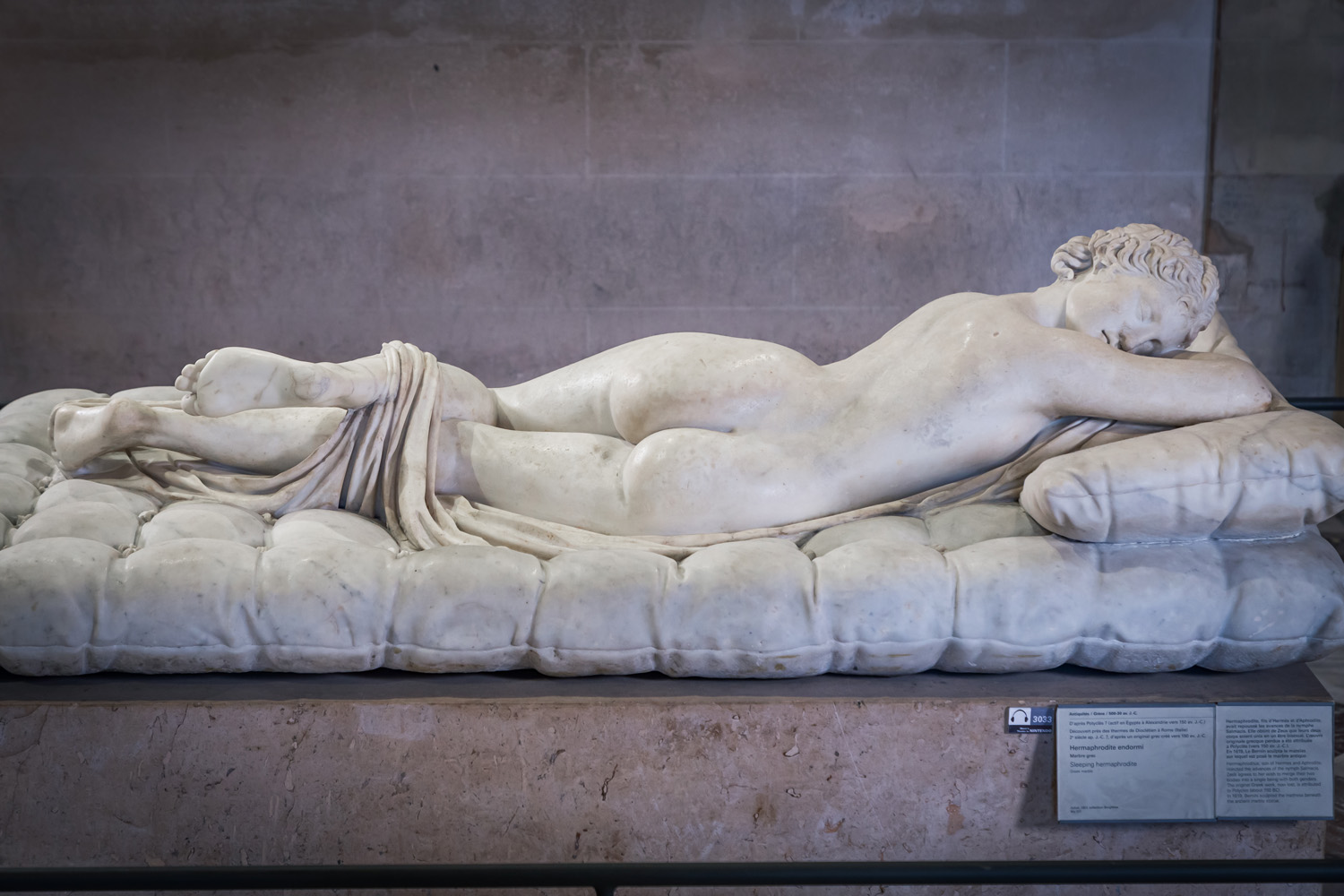 Inside ‘De toutes beautés!’, the Louvre’s new exhibition narrating 10,000 years of beauty ideals through art
Inside ‘De toutes beautés!’, the Louvre’s new exhibition narrating 10,000 years of beauty ideals through art‘De toutes beautés!’ marks the beginning of a three-year partnership between the Louvre and L’Oréal Groupe. India Birgitta Jarvis reports on the show for Wallpaper*
By India Birgitta Jarvis